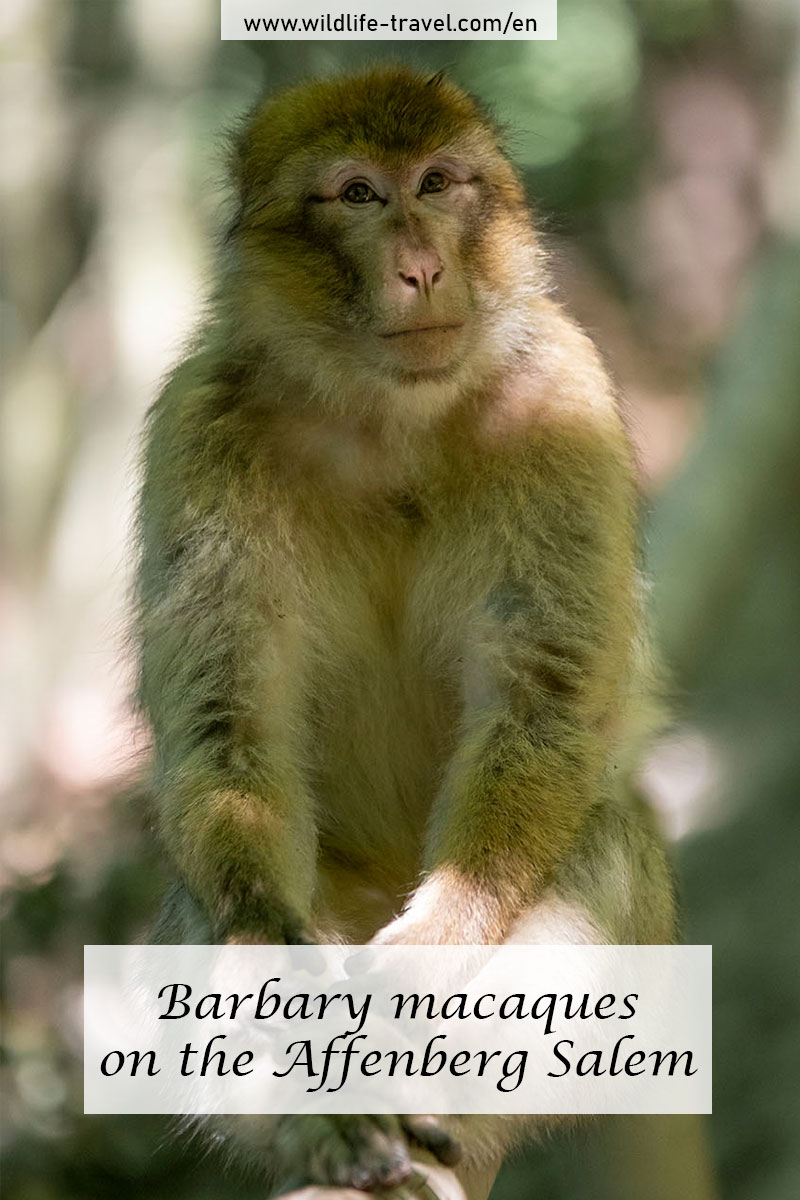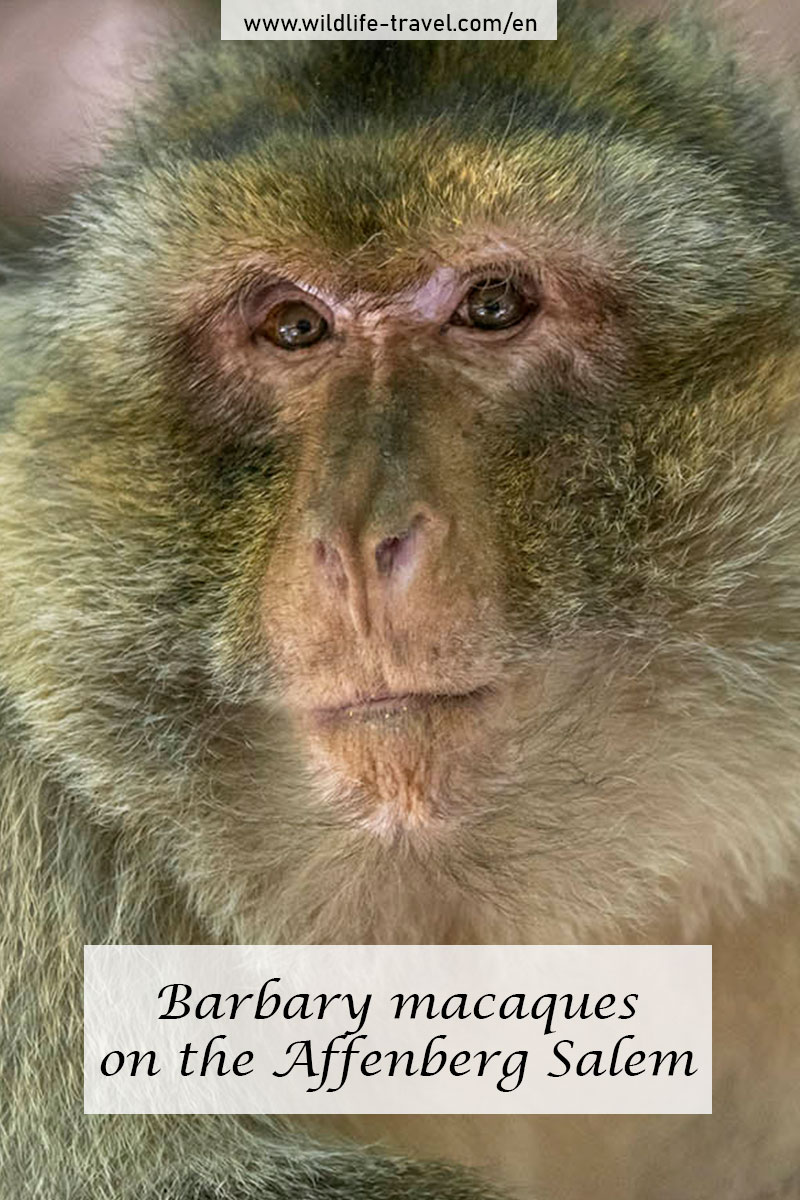The barbary macaque is a monkey that actually lives in the Atlas Mountains in Morocco and Algeria. The Affenberg Salem in the south of Germany is also home to a colony of about 200 monkeys. In this blog entry I tell you more about the Affenberg Salem and the barbary macaque as a species.
The Affenberg Salem
Cindy is a barbary macaque and very special.
In October 2019 she became the oldest barbary macaque that has ever lived on the Affenberg Salem.
She was born in March 1988 on the Affenberg Salem and reached an age of 31.5 years in autumn of the year 2019.
In the wild she probably never would have reached this age.
Maybe she would have become a prey to a predator?
Or maybe she would have suffered periods of food shortages?
Or she would have become sick and there wouldn't have been a veterinarian around to help?
Nevertheless, a barbary macaque in its natural environment usually does not reach an age of more than 30 years as there are too many threats in the wild.
Usually female barbary macaques reach an age of about 23 years and males of about 21 years.
On the Affenberg Salem Cindy was born into a safe life where she could follow most of the time one of her favorite activities: feeding.
But Cindy is only one of about 200 barbary macaques that lives on the Affenberg Salem (Update January 2020: Unfortunately, Cindy died in December 2019 according to a notification on the official Facebook page of the Affenberg Salem).
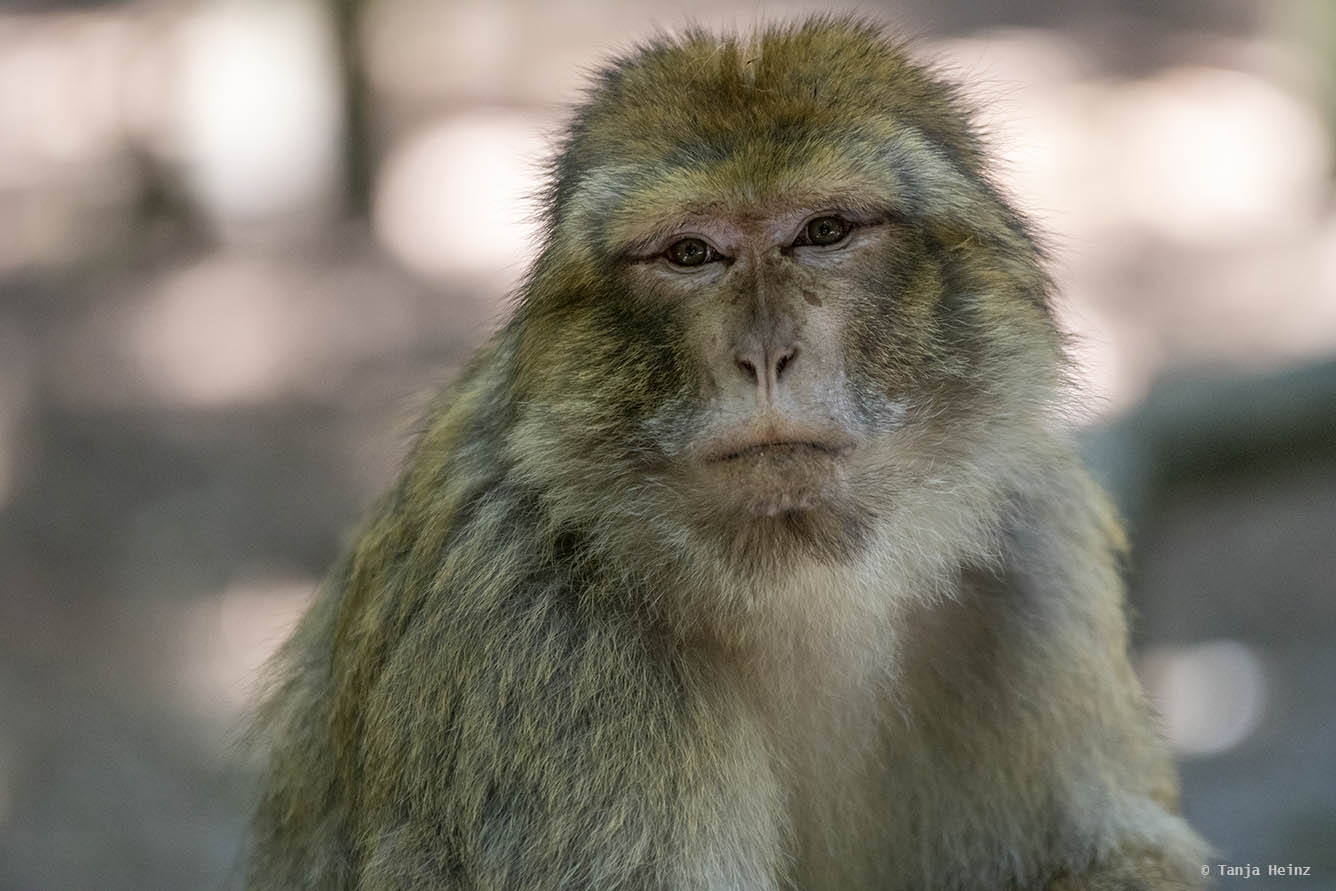
The Affenberg Salem is located in the south of Germany close to the Lake of Constance. It is a sanctuary for barbary macaques and comprises an area of about 20 hectares. As the name („Affen“ = monkey and „Berg“ = mountain) suggests, the Affenberg Salem is characterized by a hilly terrain. A dense forest covers the area of the Affenberg Salem and a fence protects the barbary macaques from other wildlife like foxes.
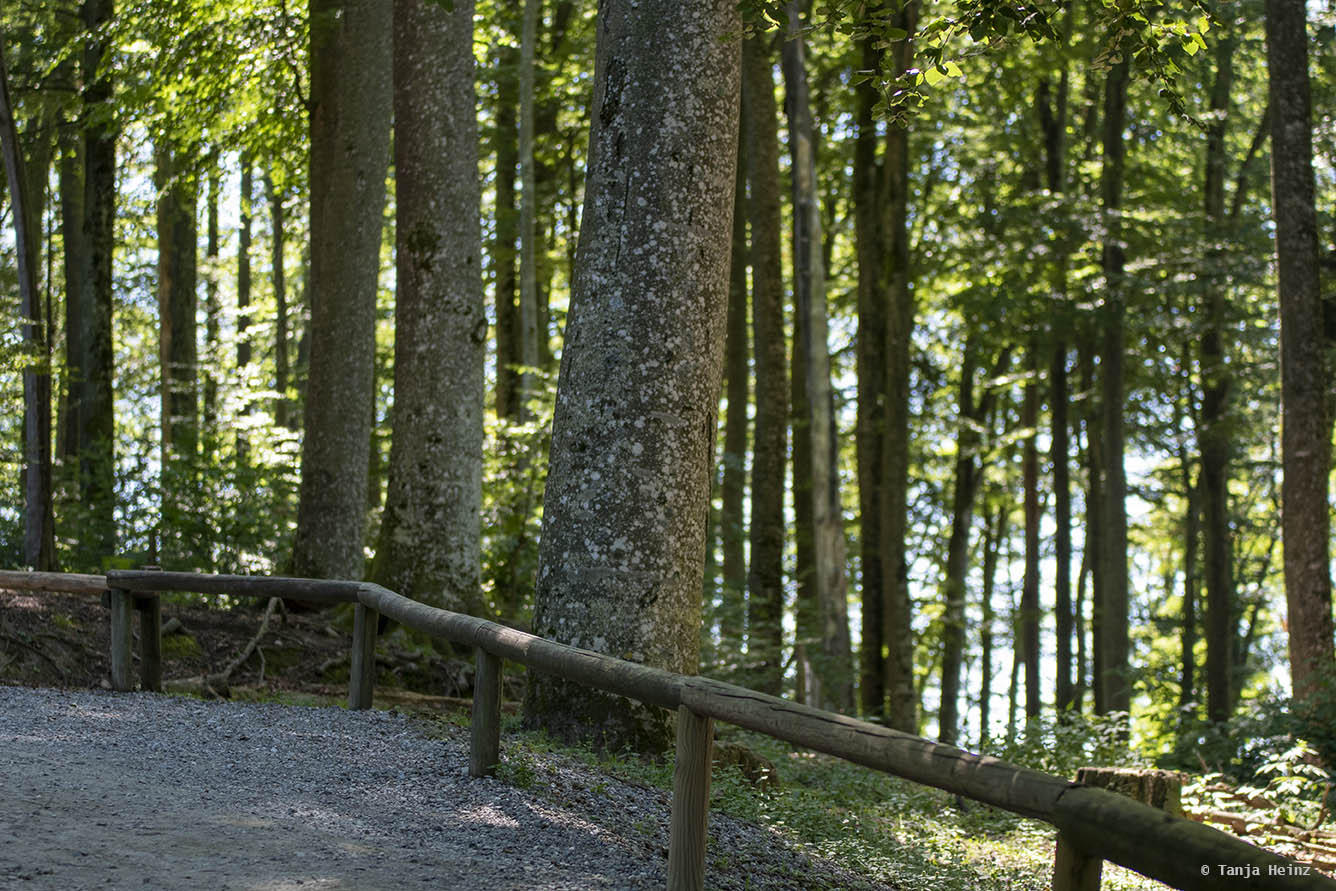
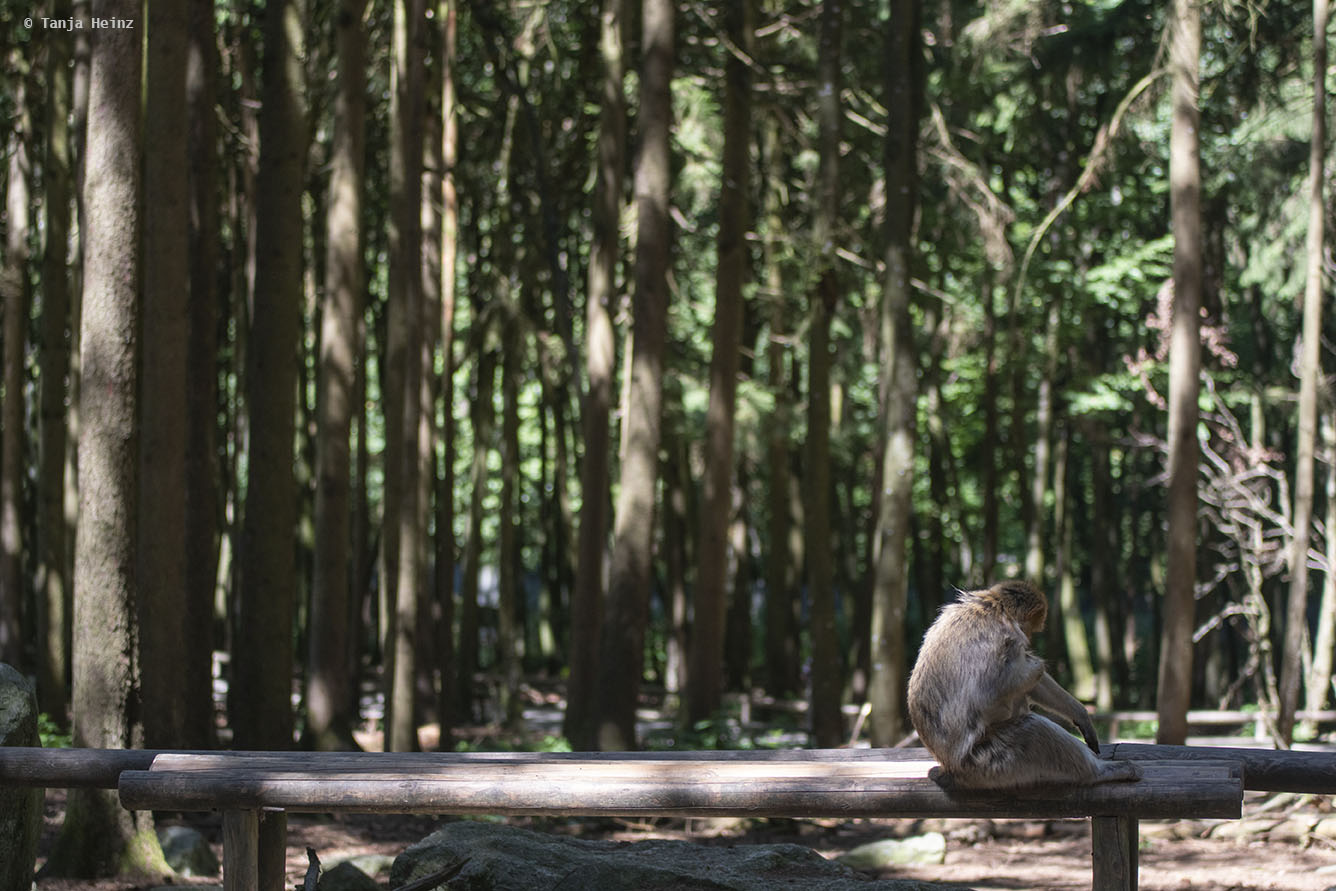
Close-by is a stork sanctuary.
In summer you can observe quite many breeding pairs of white storks in the entrance area of the Affenberg Salem.
The barbary macaque
The latin name of the barbary macaque is Macaca sylvanus.
Macaques are Old World monkeys, and thus, only occur in Eurasia and Africa, but not in the Americas like golden lion tamarins, capuchin monkeys or southern muriquis which are New World monkeys.
On the Affenberg Salem you can encounter barbary macaques close up. This is actually a very special encounter as barbary macaques are endangered according to the IUCN.
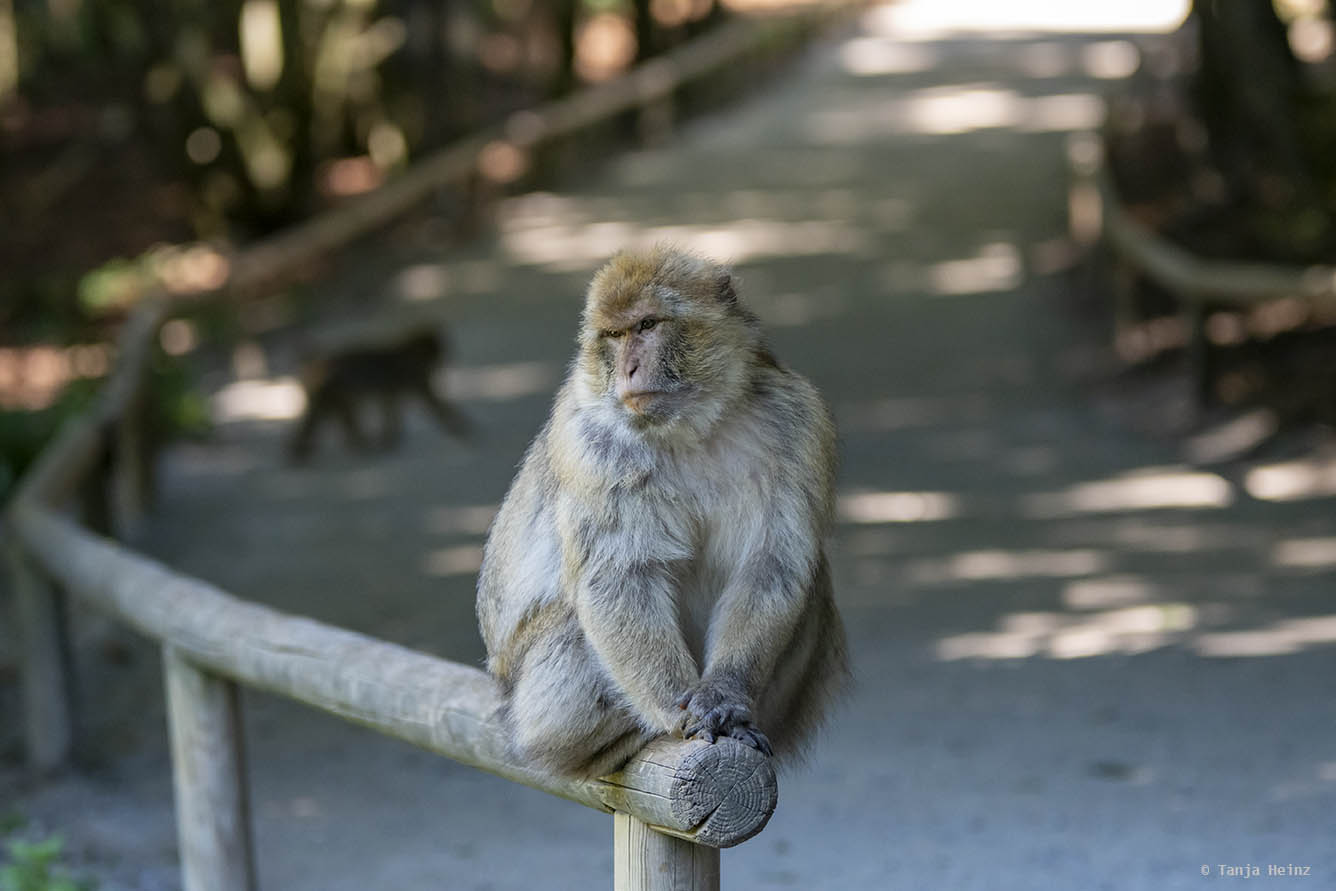
Apparently, there are less than 10.000 barbary macaques left in the wild and the number seems to be further in a decline.
Nowadays, the barbary macaque mainly lives in the Atlas Mountains in Morocco and Algeria. There, they inhabit open and forested regions, especially cedar and oak forest, but also grassland and scrubby and rocky areas.
Although they mainly occur in Morocco and Algeria, there also exists a population outside of northern Africa in the south of Spain in Gibraltar. It is the only primate species that lives in Europe. Why barbary macaques ended up in Gibraltar is still not that clear. Possibly, the barbary macaques in Gibraltar could have been part of a once large population spread over Europe.
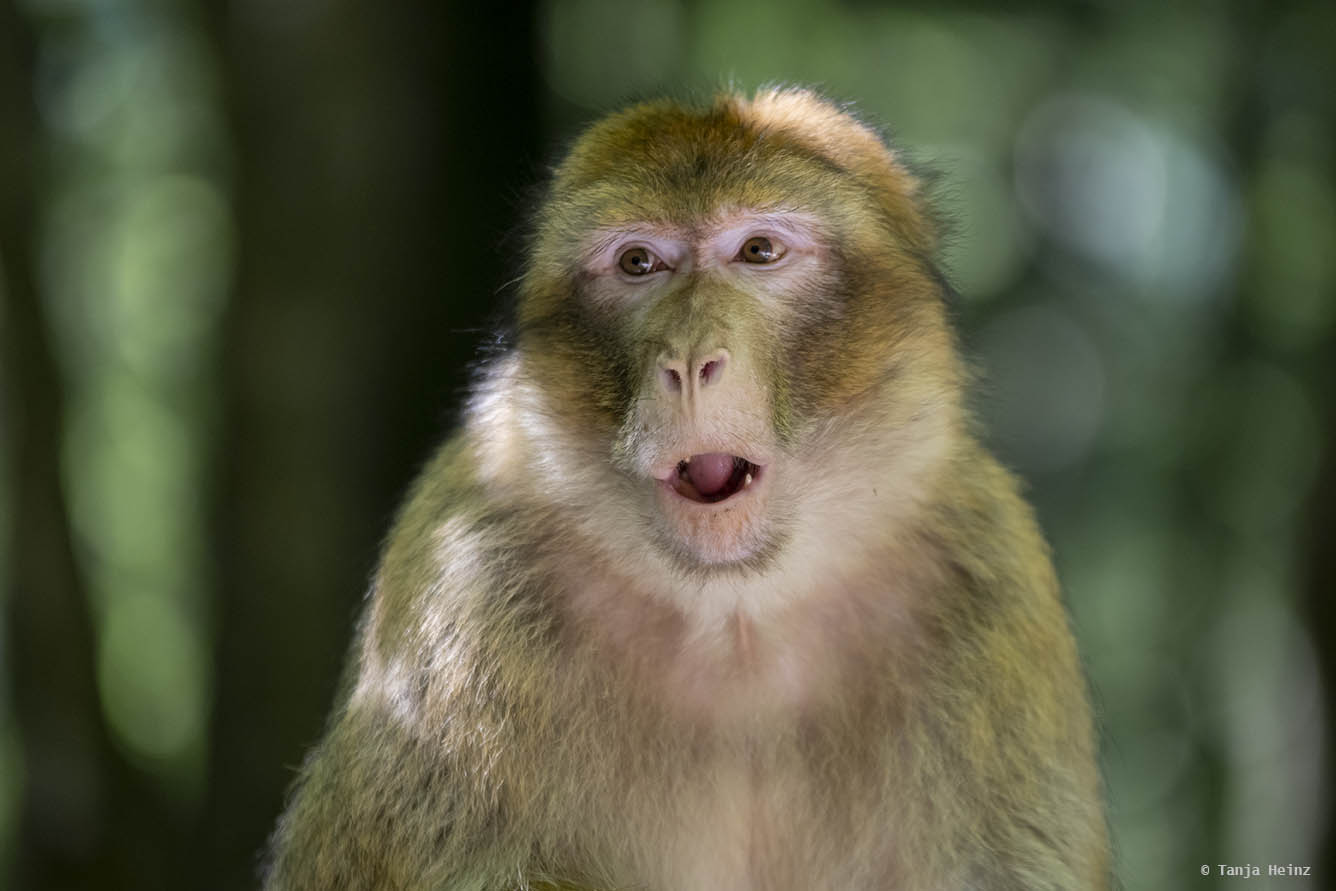
Interestingly, the barbary macaque is the only primate species that lives north of the Sahara desert and the only macaque species of the Genus Macaca that occurs in areas outside of Asia. All other macaque species - except the barbary macaques - live in Asia.
In general, if you take your time walking through the forest on the Affenberg you can learn a lot about barbary macaques.
Several small information boards tell you more about the barbary macaque as a species.
For example, where do barbary macaques come from?
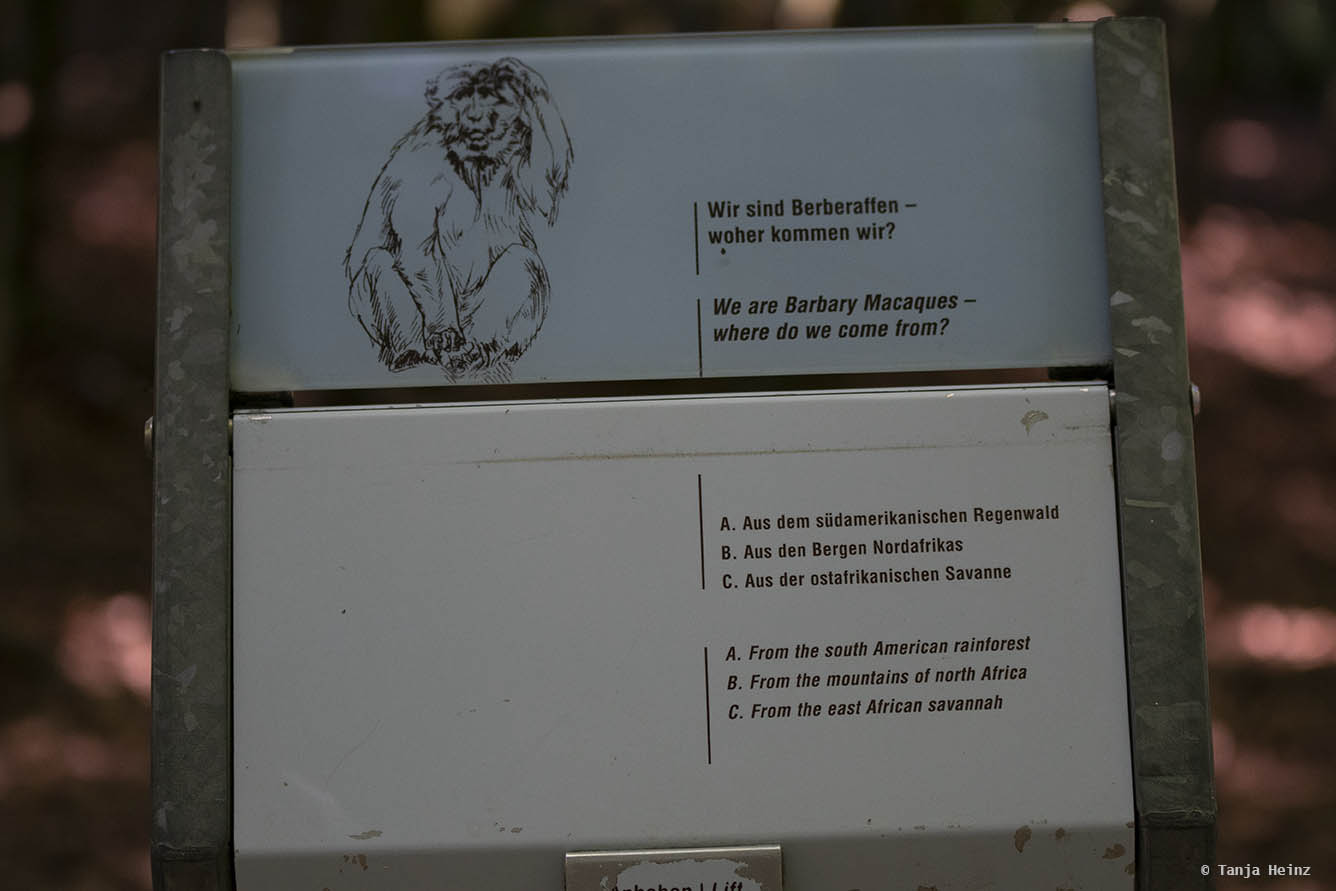
You can also check the feeding times of the barbary macaques where a staff member spreads some fruits and vegetables, and simultaneously, tells you more about the species itself and the barbary macaques on the Affenberg Salem.
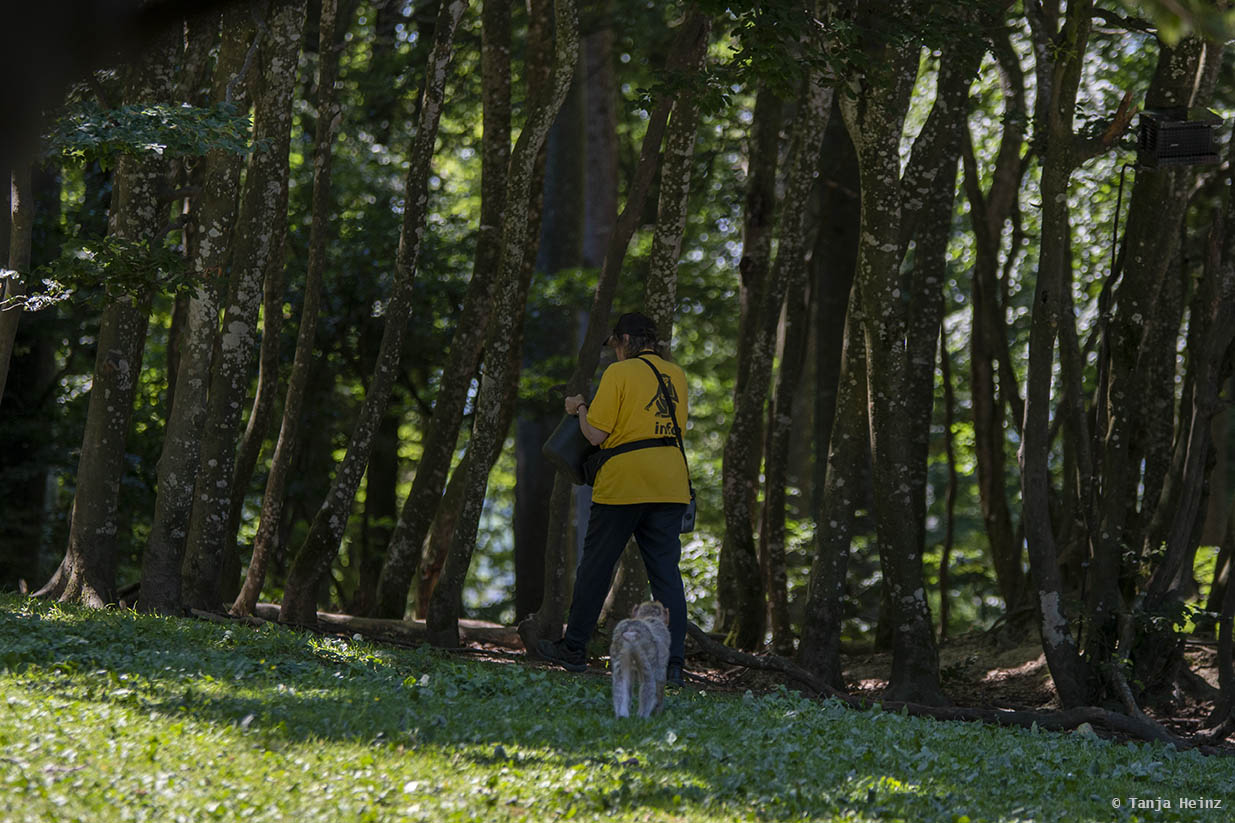
I learned that the barbary macaques on the Affenberg Salem remain outside the whole winter. Their winter coat protects them from the cold. Like in Morocco and Algeria. In northern Africa barbary macaques can live in heights of up to or more 2000 meters where it could be even colder and where more snow might fall.
Apparently, on the Affenberg Salem the barbary macaques use every sun ray in winter in order to get warm. They also cuddle up when it is very cold.
In their natural habitat barbary macaques have to survive extreme environmental conditions. While in winter the temperature can drop to below 0°C, in summer it can be as hot as 40°C. One physical adaptation to the extreme seasonal cold and hot conditions is the moulting of their fur.
I also learned during the feeding session that barbary macaques give birth in spring when it is not that cold as babies are not born with a thick fur that would protect them from the cold. Furthermore, mothers give birth when food availability increases, as they need more energy to feed their young.
Interesting: After birth babies do have a black fur. After the second month the fur color starts to change and the babies get a more typical grey-brown fur color. After the 5th or 6th month the babies have completely changed their fur color.
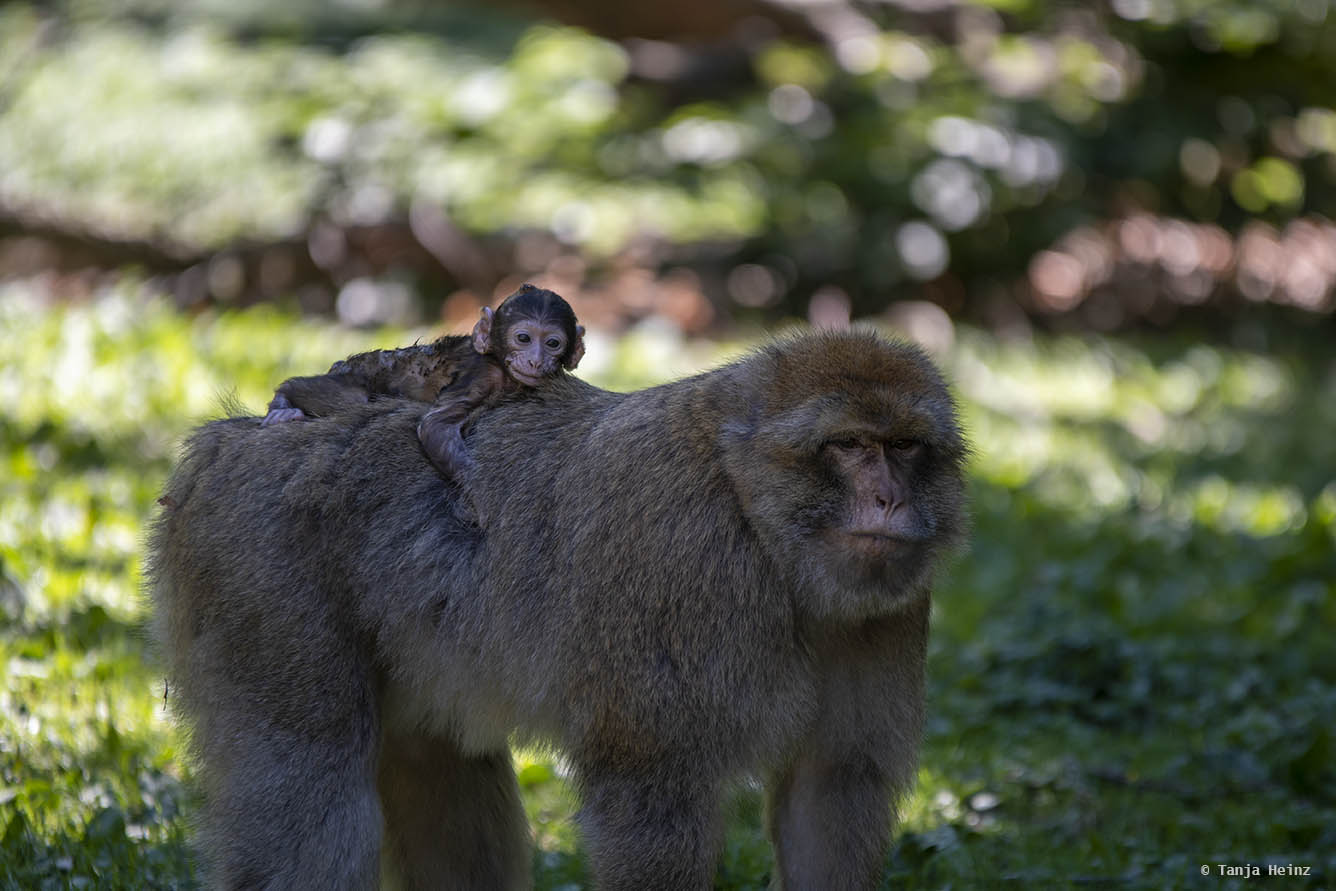
Within a barbary macaque group exists a strict hierarchy with high-ranking and low-ranking animals. High ranking macaques have first access to food and other resources. Furthermore, high ranking animals are more successful with respect to breeding.
Males usually outrank females. Males reach their highest ranks within a group at the age of 10 to 15. An alpha male needs support by group members, and thus, is typically successful in forming coalitions and friendships with other males to reach the top of the hierarchy.
Among females also exists a hierarchy. Females transfer their rank to their daughters at birth. Meaning, a high-ranking female gives birth to an already high-ranking baby and a low-ranking female will give birth to a low-ranking daughter.
On the Affenberg Salem, for example, Ragana became a high-ranking female. Her mother was already a high-ranking monkey within the group. Ragana got a lot of support in the first weeks of her life and she reached the highest position of the hierarchy among females at the age of 13. She was always very close to her aunts, cousins and brothers and sisters.
Low-ranking females at birth do not have good chances to climb up the hierarchy in the group.
Interestingly, males do have more chances to climb up the hierarchy within the group.
For example, Adonis was once the alpha male of the largest group of barbary macaques on the Affenberg Salem. He was the alpha male for about 5 years, but after an injury he lost its high rank in the group.
Important to mention here is that physical fitness is not sufficient for becoming an alpha male. An alpha male needs especially many coalitions and friendships with other male barbary macaques. A lone fighter does not have much support and usually does not reach the top of the hierarchy.
Barbary macaques also live in a highly promiscuous mating system. As females mate with several males, barbary macaques do not know paternity. Meaning, the mother is known but not the father. As the paternity is not known, a male might care for a young as he could be the potential father of this young. Males especially care for the young in the first weeks, however, they prefer high-ranking and male babies.
Insteresting: Males do care for the young as they are not sure about paternity. However, male barbary macaques even use babies as a tool in order to approach other males. The baby is used like a white flag and signals peaceful intentions. This way a low-ranking male can even approach a high-ranking barbary macaque. This behavior could be observed so far only in barbary macaques.
During the feeding time I also learned that there are some differences between males and females.
For example, males possess larger canines than females.
Males in general are larger than females.
While females reach sexual maturity at the age of about 6 years, males become sexual mature about two years later with more or less 8 years.
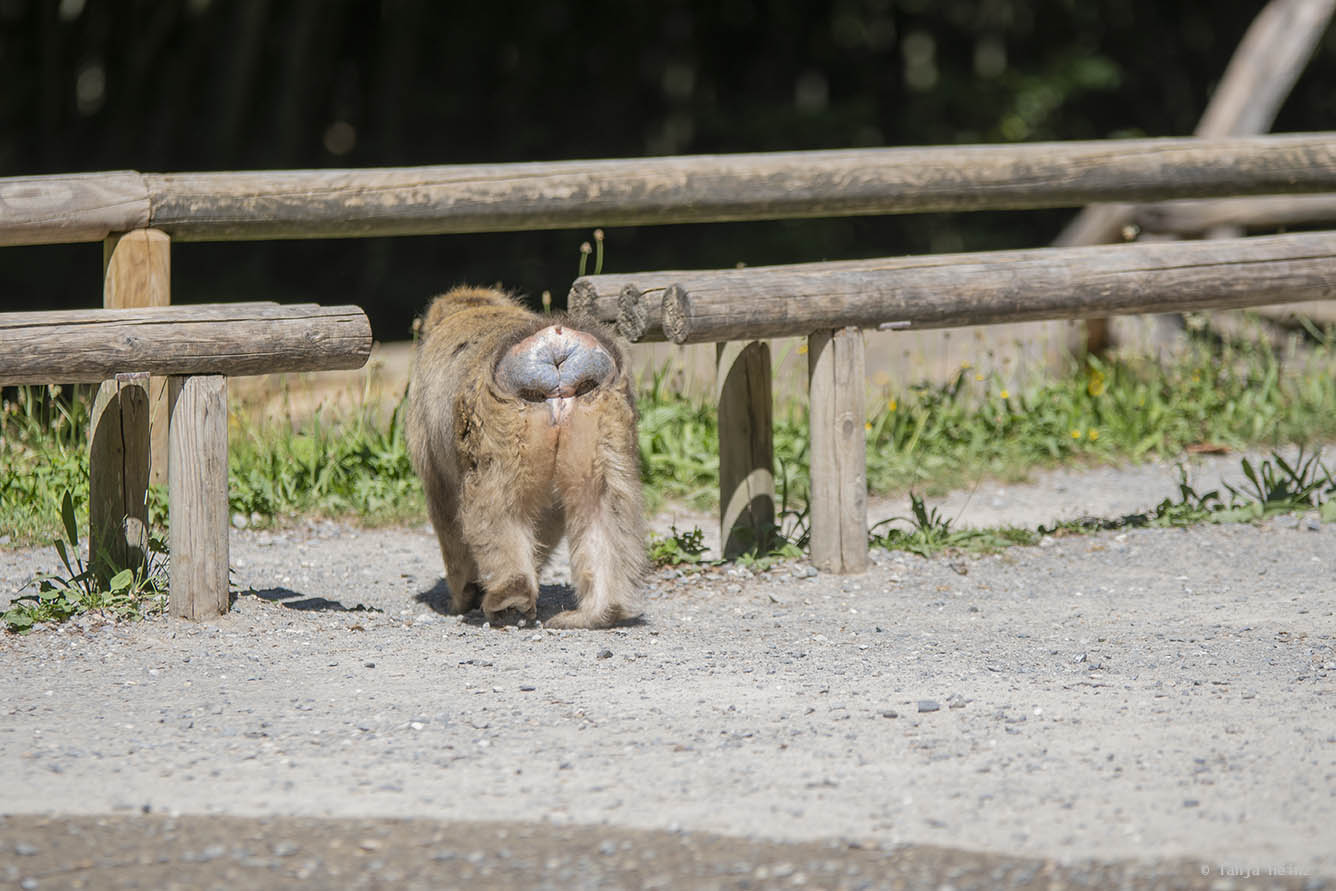
Interesting: Could you see in the previous photograph that barbary macaques lack a tail? This is an adaptation to their quadrupedal locomotion. Therefore, they are often named as barbary ape as apes like chimpanzees or gorillas do not have a tail. However, barbary macaques are monkeys with vestigial tail and not apes. Other macaques like rhesus macaques do have a tail.
On my visit I also could observe some social interactions between the monkeys. Apparently the social behavior of the barbary macaques on the Affenberg Salem does not significantly distinguish from the social behavior of wild barbary macaques.
I observed some individuals playing, especially the young barbary macaques.
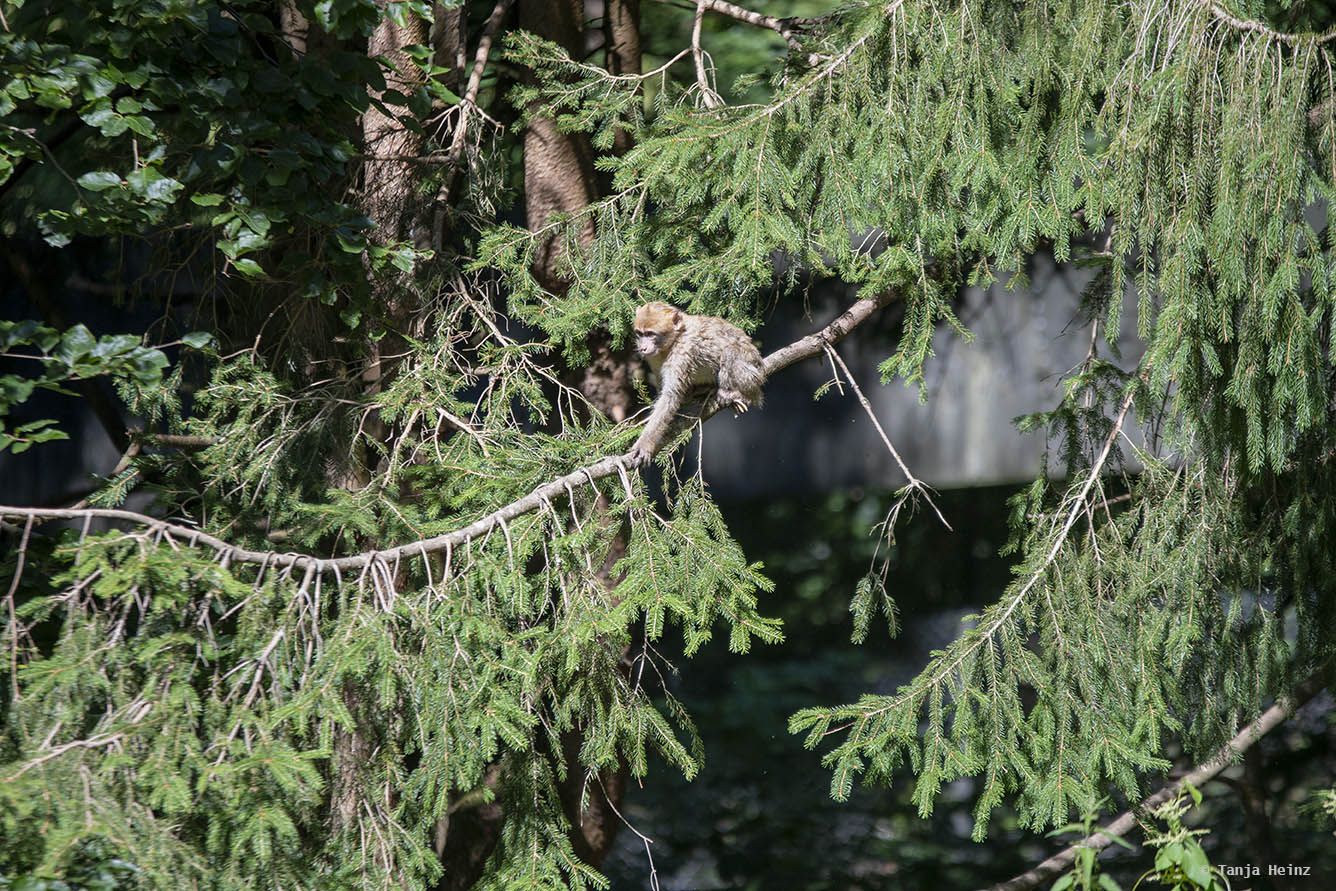
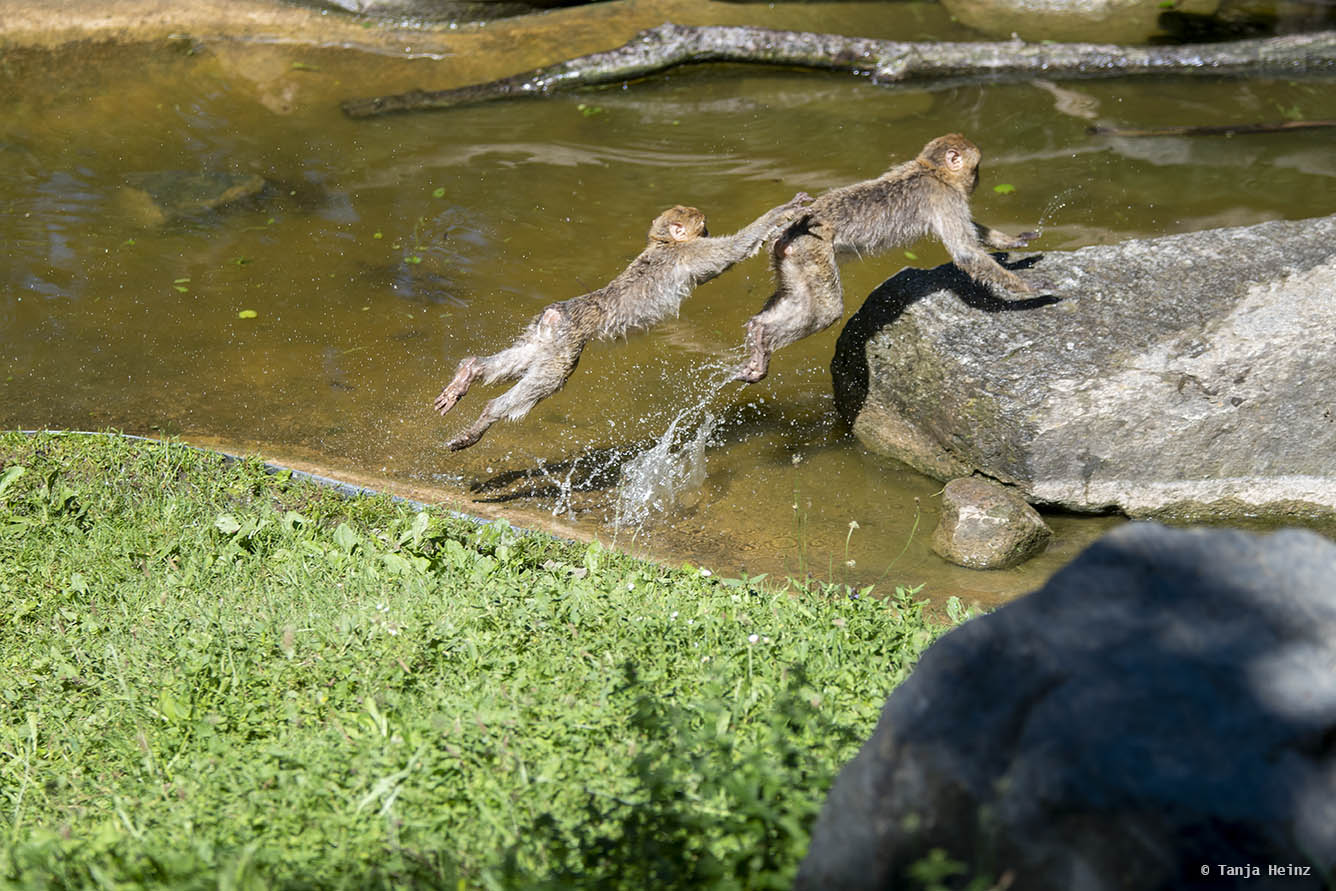

The social system of barbary macaques is very complex. They live in groups with several males and females. While females remain in the group where they were born, males migrate to other groups. Males usually migrate to other groups when they are between 3 to 5 years old. In that age they are not considered as competitors as they are still too small, and thus, it is easier for them to integrate in a group. Sometimes a male might form a temporary group with other males.
Therefore, groups of barbary macaques usually consists of related females including offspring (matrilines) and unrelated males.
As barbary macaques live in social groups, you can observe many different behaviors like playing or grooming, but also aggression.
Interestingly, dominant barbary macaques show more grooming interactions within a group when compared to their lower-ranking conspecifics.
Interesting: Did you know that a group of barbary macaques can be as large as 80 monkeys? However, the average group size reaches only about 40 animals.
In one moment I spotted two barbary macaques in a tree grooming each other while some other monkeys were huddling together.
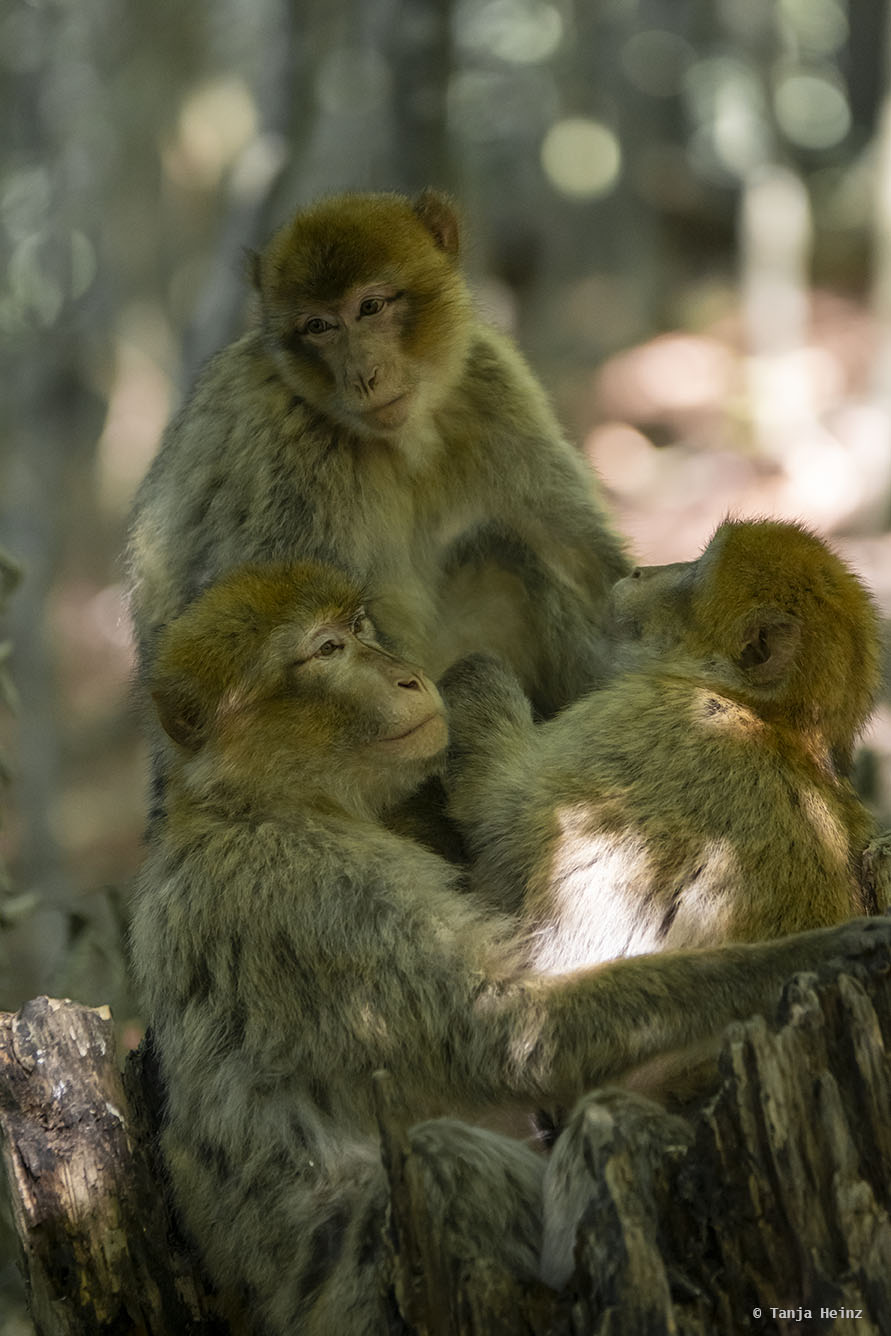
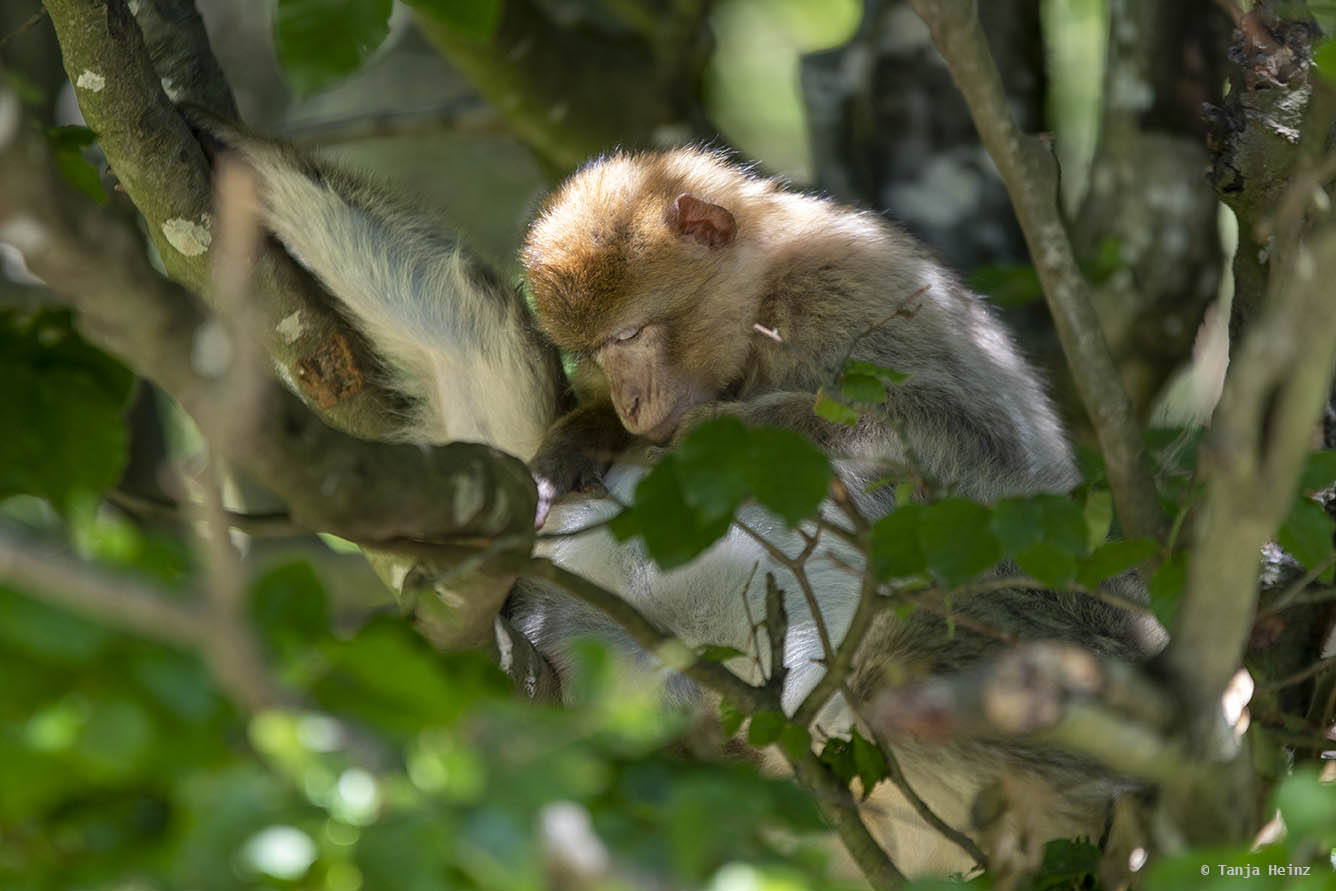
Grooming is very important among these macaques. The main aim of grooming is not necessarily removing parasites or cleaning the fur. Monkeys like barbary macaques use grooming to establish relationships to get help in conflict situations that might occur in the future.
I especially spent much time below a tree where three barbary macaques made themselves comfortable on a branch.
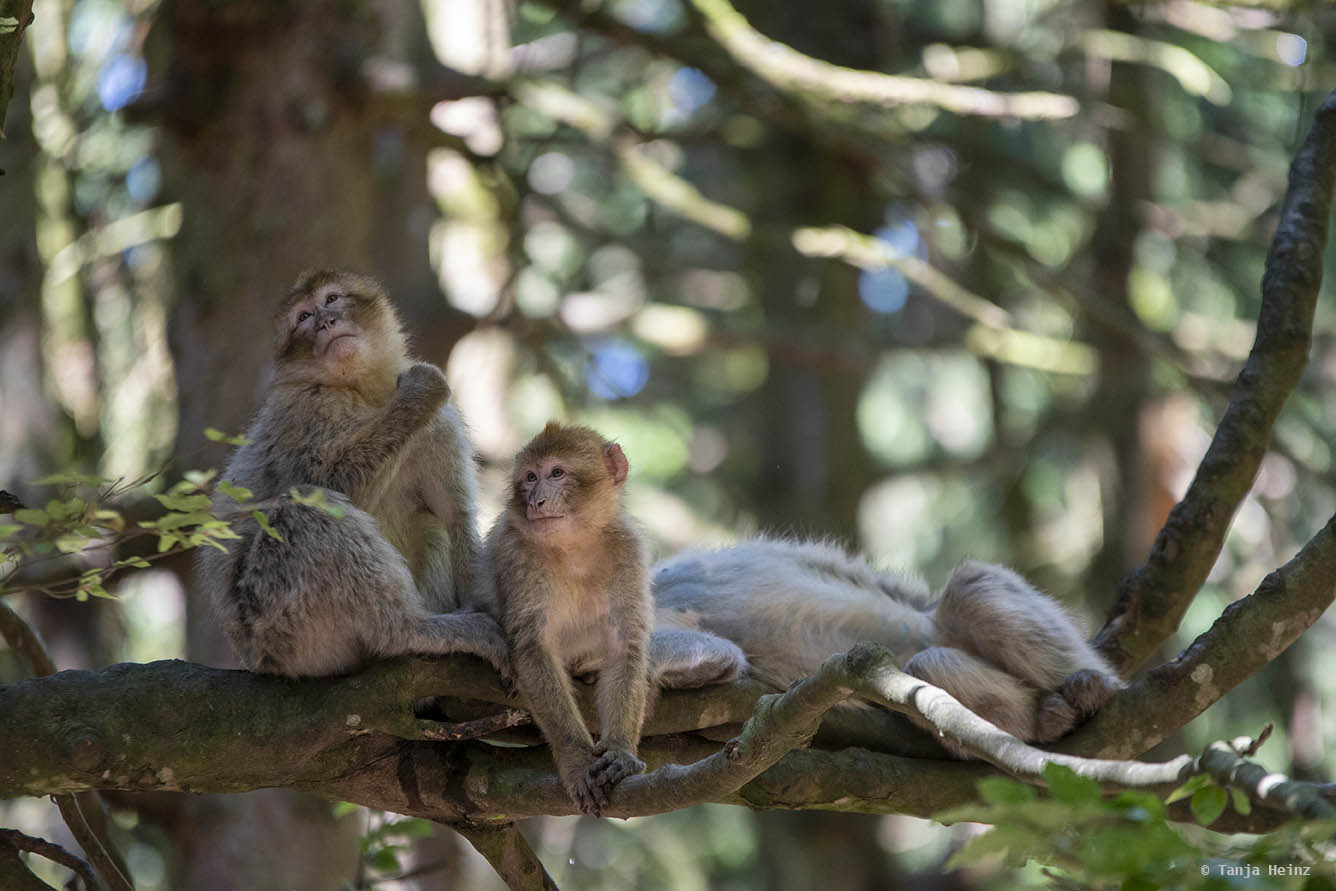
Where they related? I asked myself.
Probably.
However, I cannot tell for sure.
Maybe it was a mother with two of her daughters?
At least one of the monkeys seemed to be young.
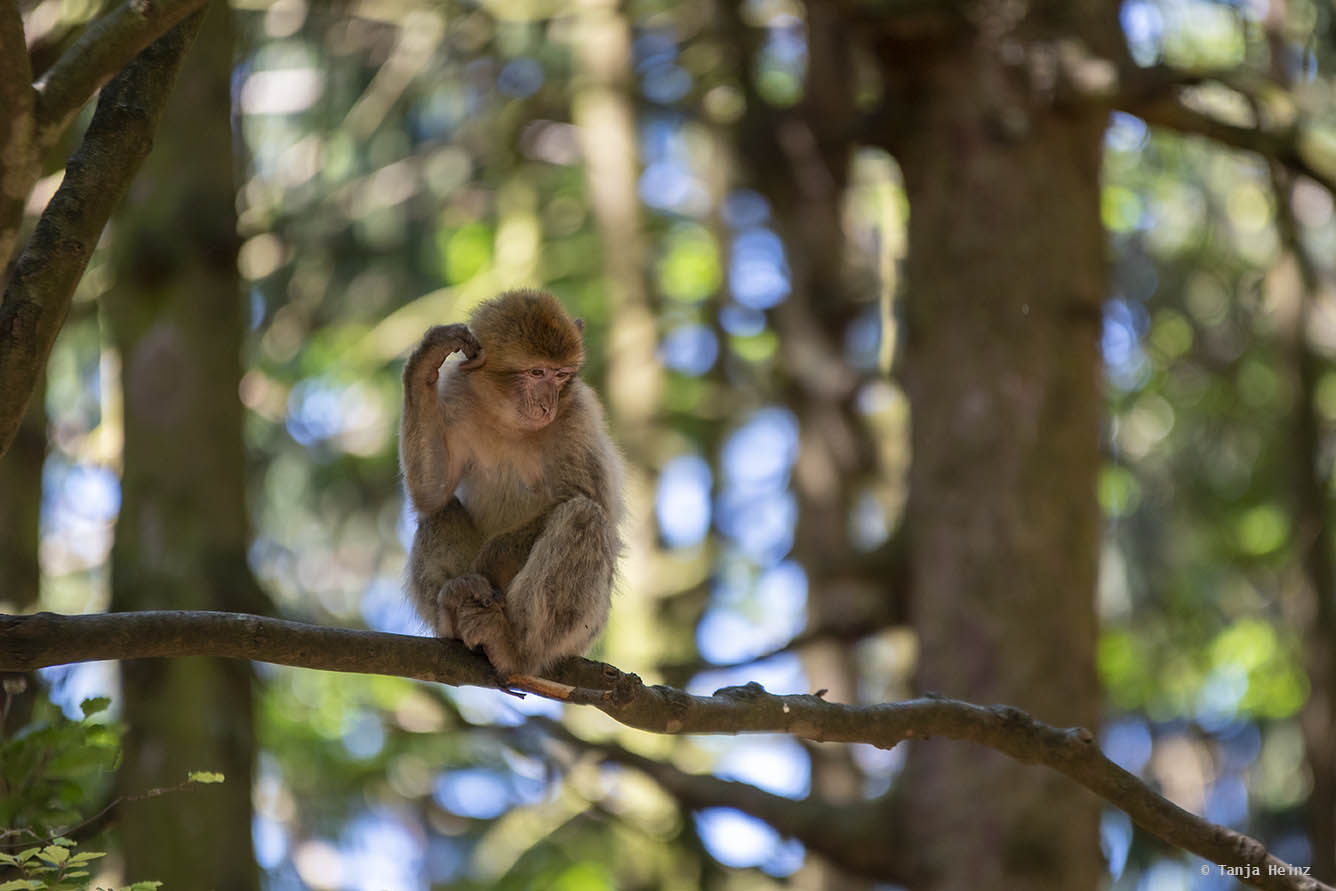
In general, females give birth to only one infant in a season and usually "only" every 1.3 years.
On average, females give birth to their first infant at the age of 5.3 years.
Interesting: Did you know that females give birth to their young on trees? This way, the babies are protected from predators like panthers, jackals or foxes.
I observed their interaction, but could only guess the meaning of their social interactions.
If you want to know more about facial expressions in barbary macaques, you can check the following scientific article.
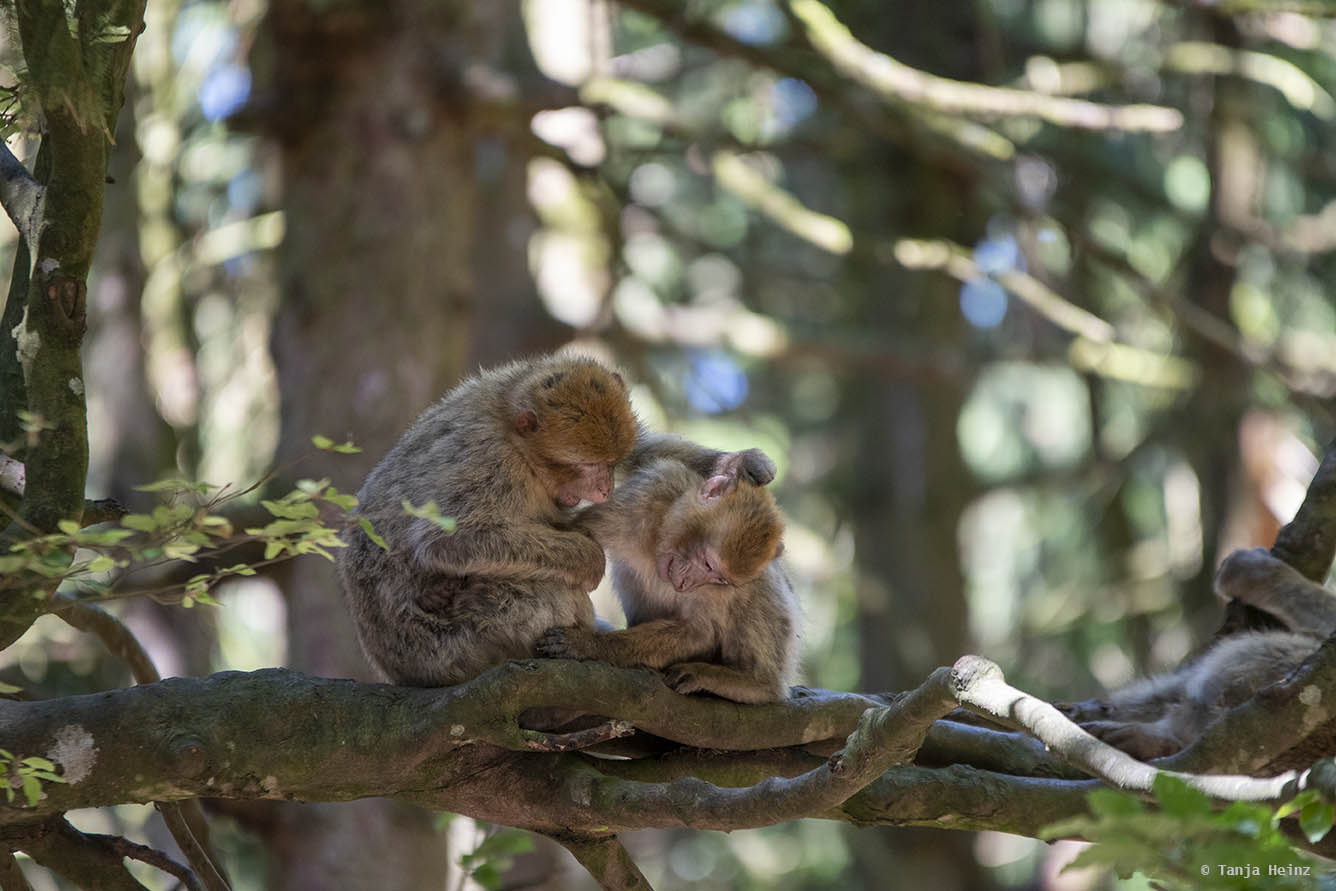
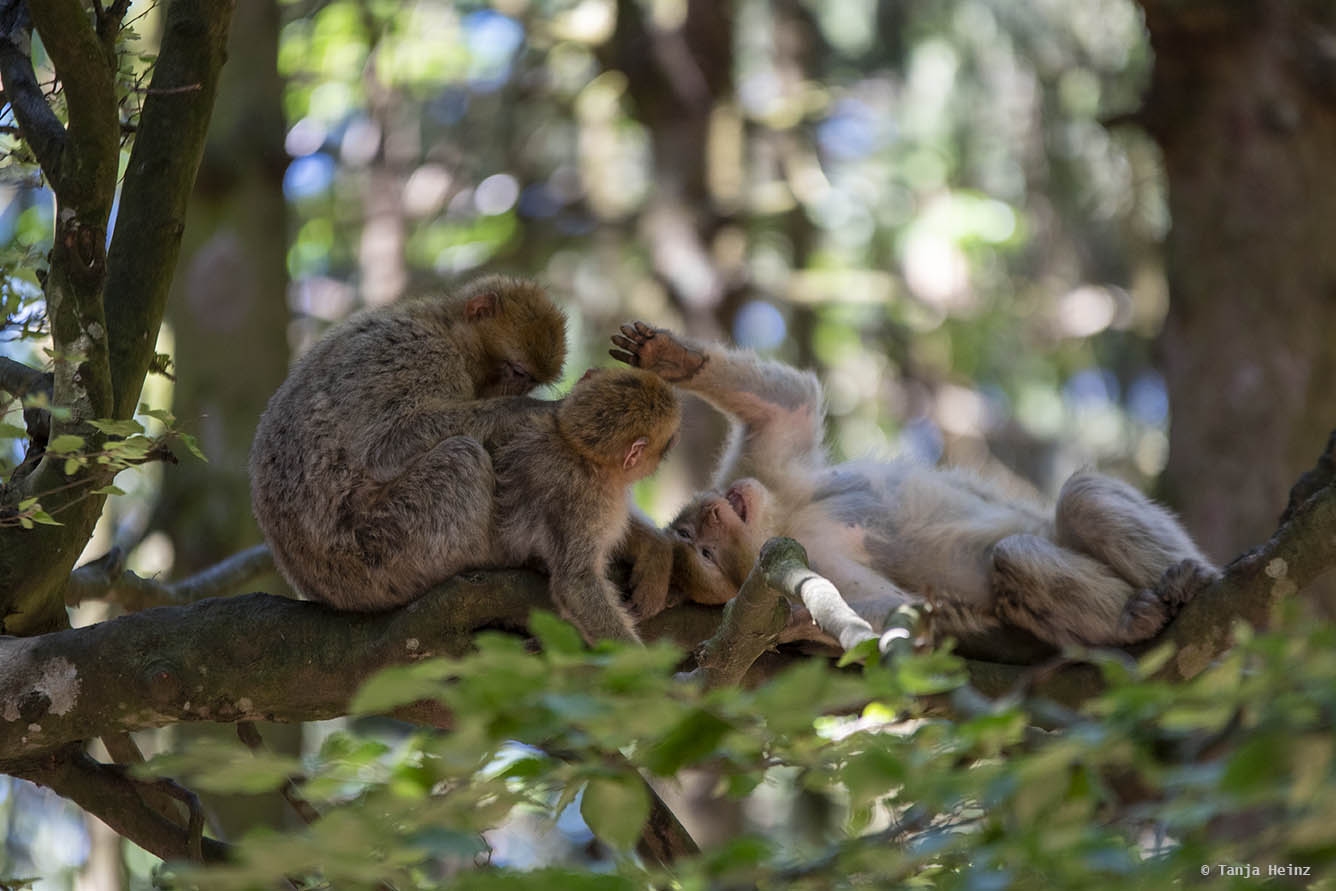
If you are lucky, you can see many different behaviors like, for example, climbing, having a nap or sleeping, eating grass, carrying a baby, playing, drinking water and so on.
You just need luck and patience.
I was lucky enough to see the small barbary macaque of the three hanging on some tree branches.
I found it quite amusing observing this young barbary macaque.
And I was impressed how strong and agile these amazing monkeys are.
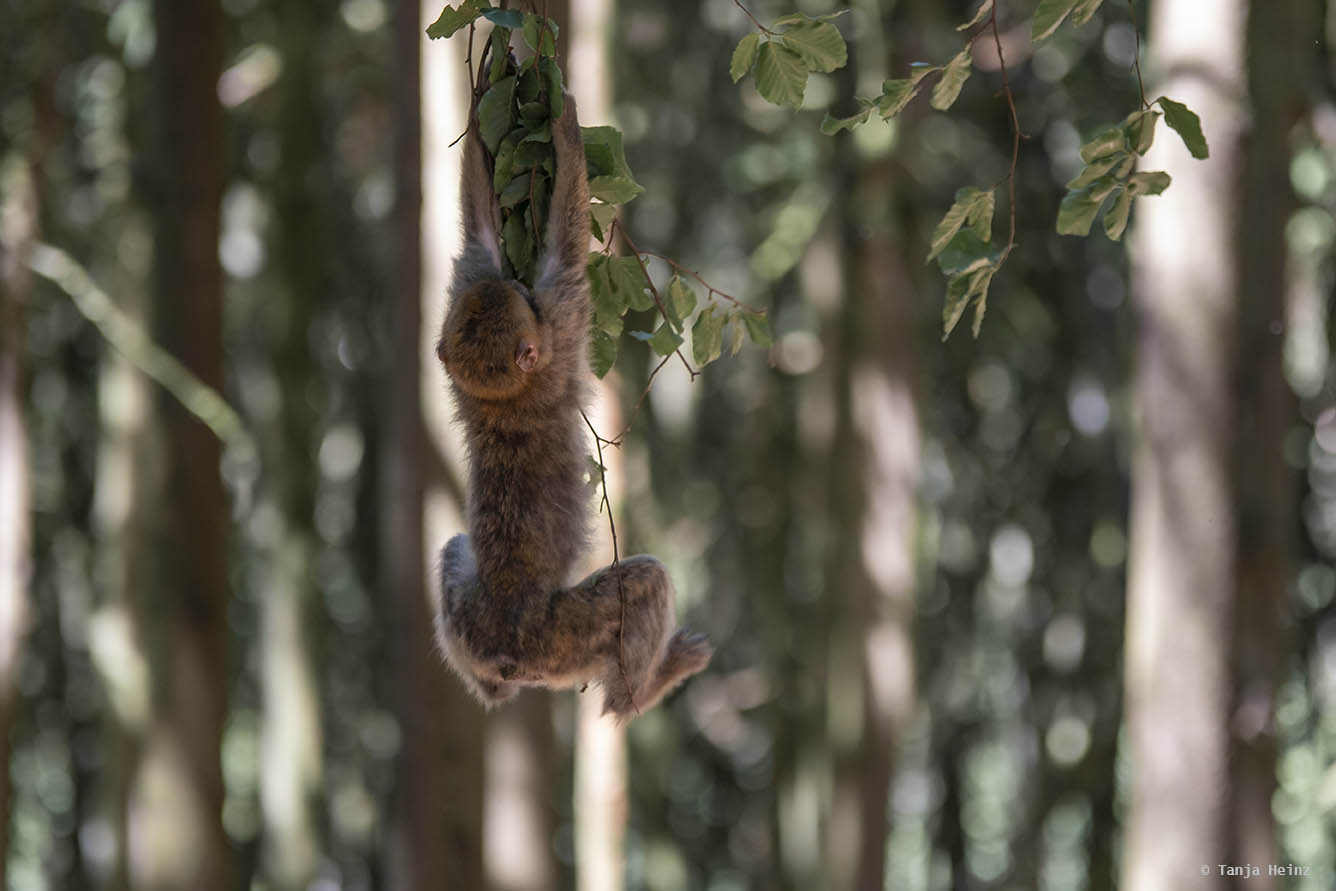
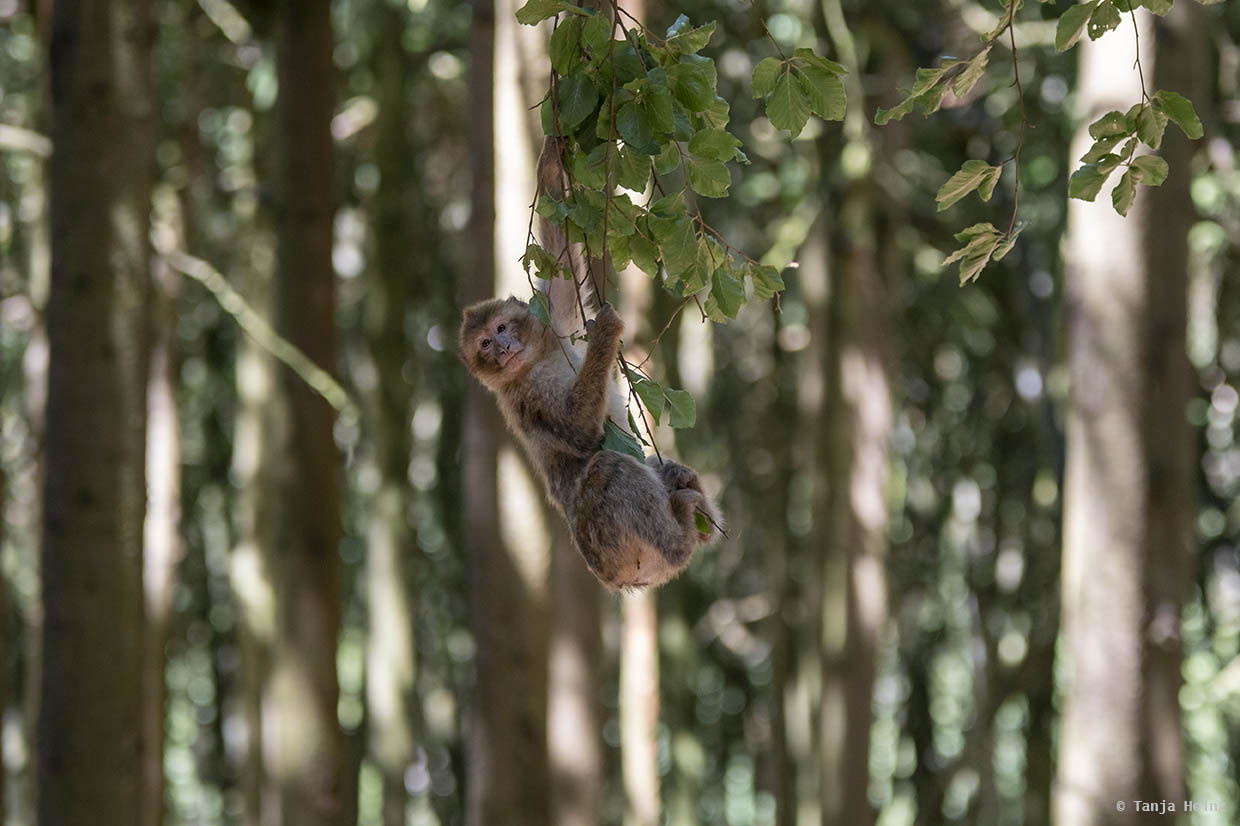
In that moment I remembered the southern muriquis of Brazil. While southern muriquis do have a prehensile tail, which they use for locomotion or climbing, barbary macaques lack a tail at all which they could use for moving from tree to tree.
Anyway, barbary macaques are also very good climbers.
Just below the small playing monkey was another monkey dozing.
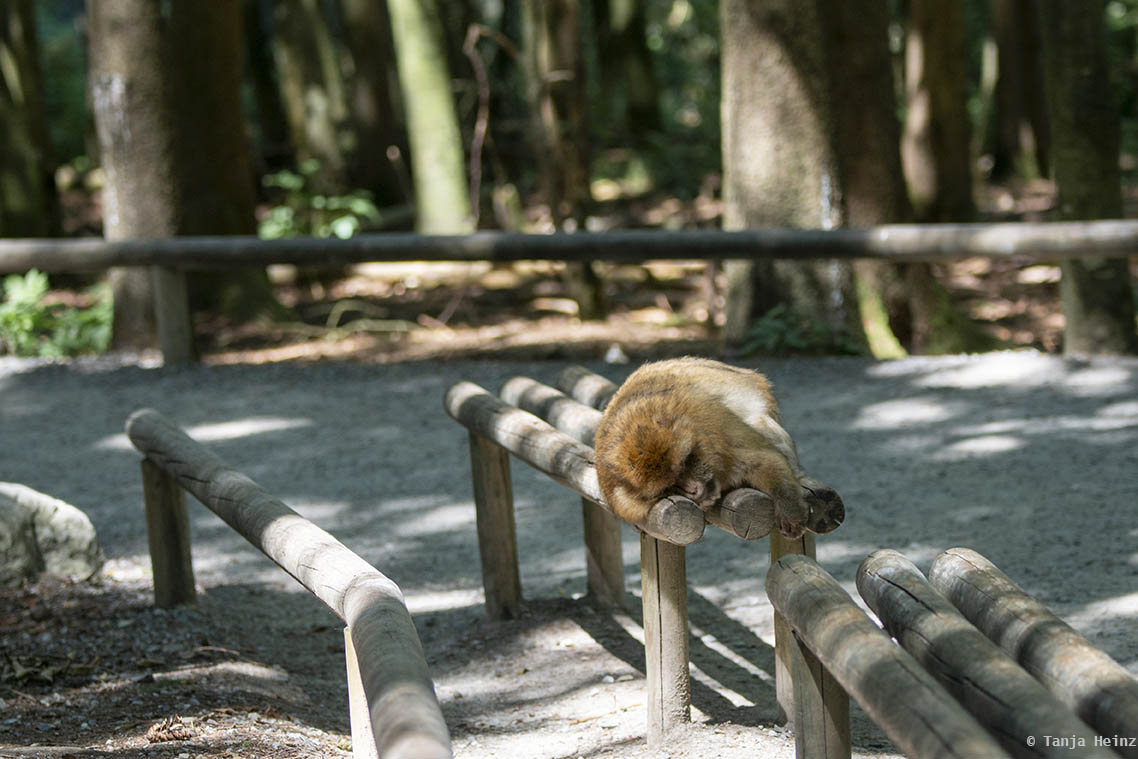
As it was such a hot day on my visit, I saw quite many barbary macaques sleeping in different (and funny) sleeping positions. Barbary macaques stay on the ground most of the day usually for feeding. However, during the night they sleep in trees.
Although there are no predators for the monkeys within the enclose, the barbary macaques on the Affenberg Salem also sleep in trees.
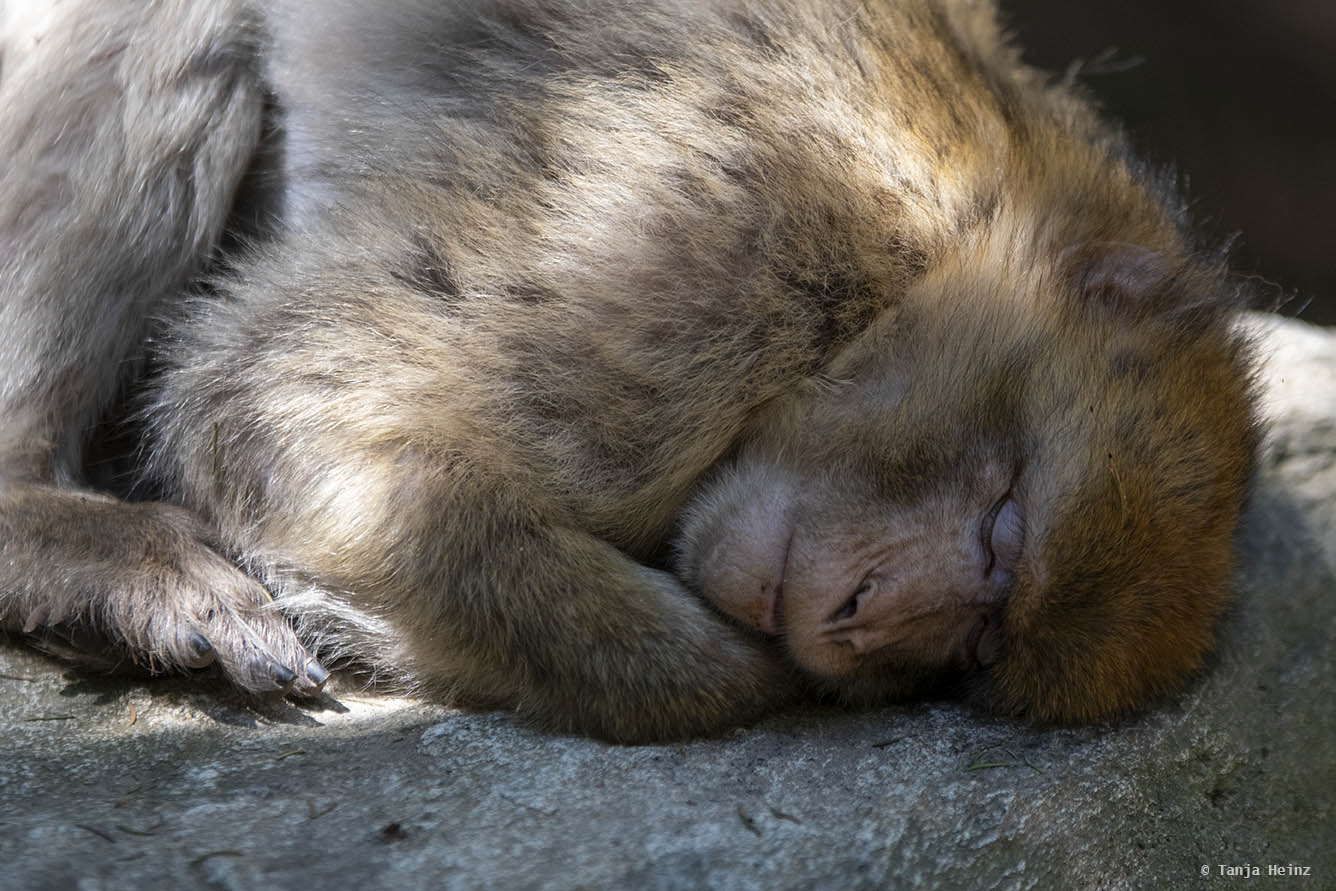
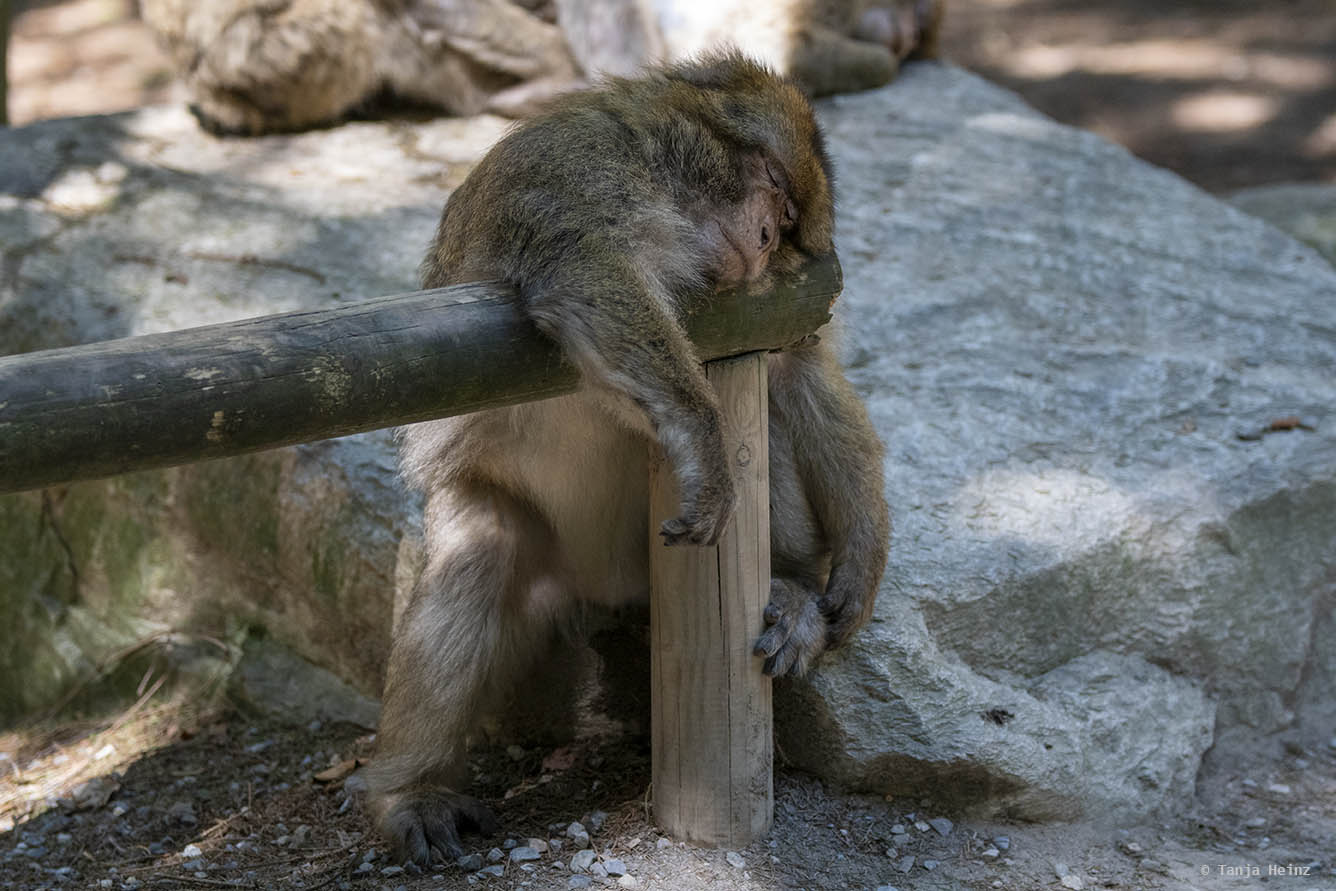
One thing that makes the Affenberg Salem interesting for many people, is the chance to feed the barbary macaques with popcorn.
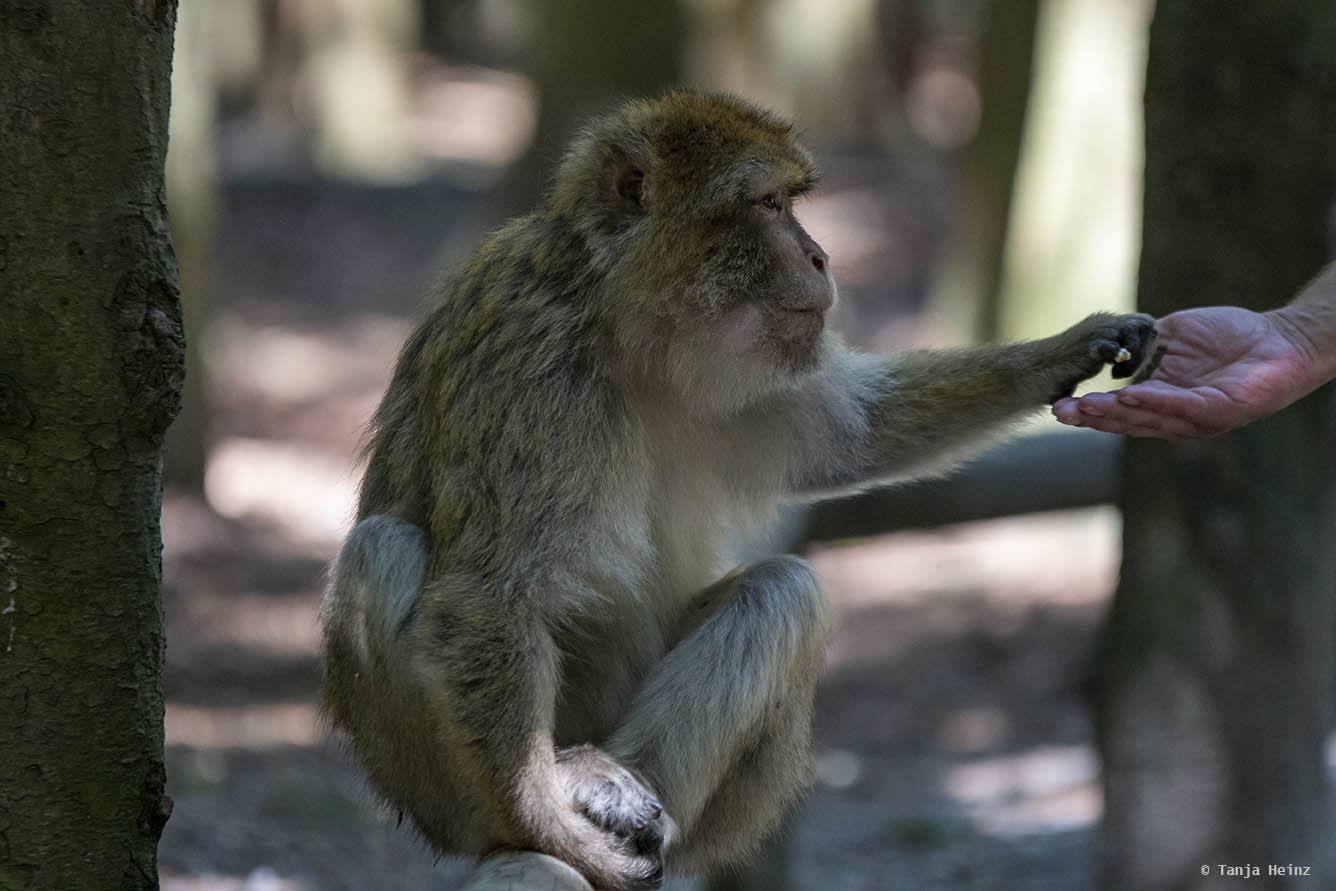
Some might just sit at the path and wait for a visitor to pass by.
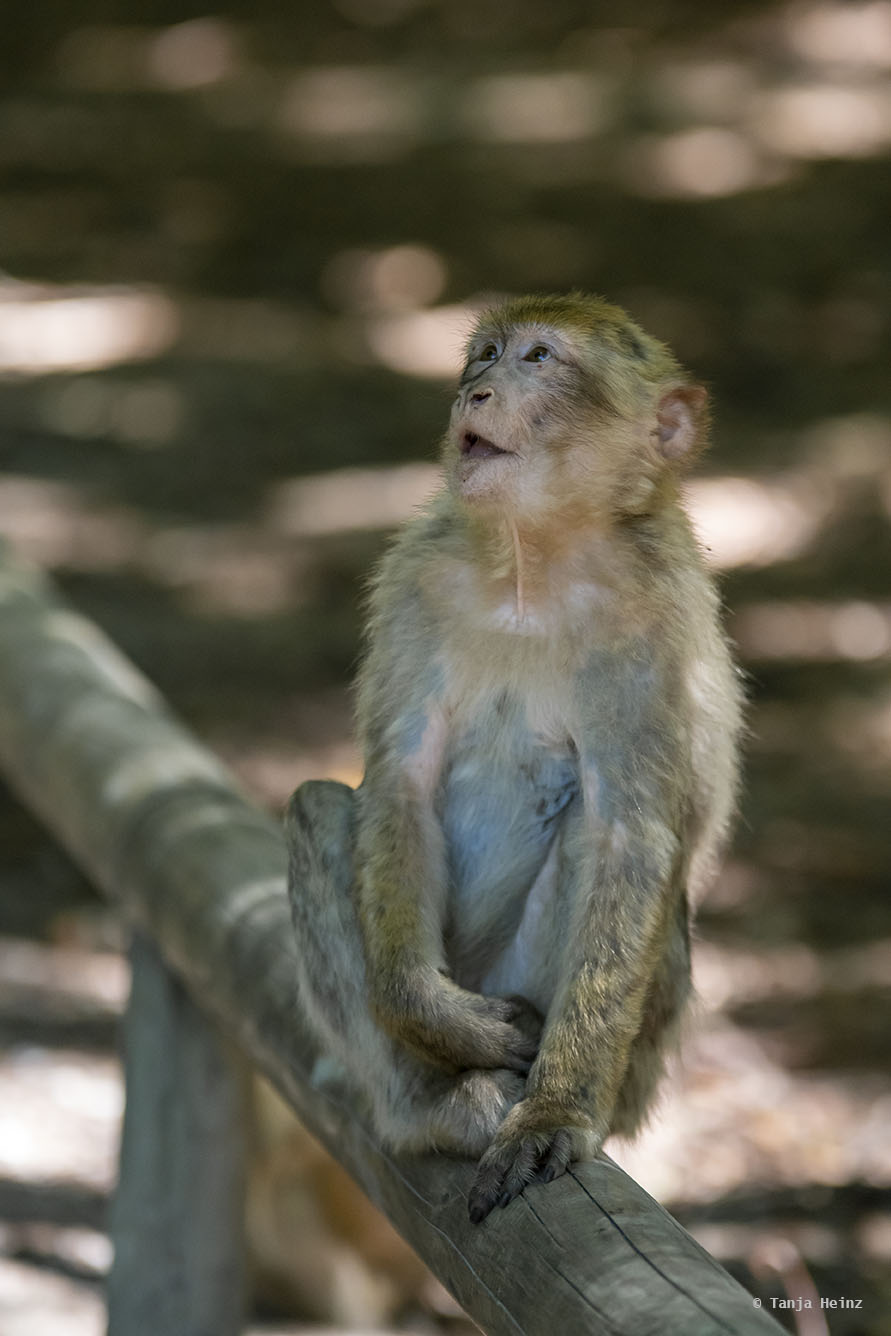
Important to mention here is that the popcorn is only a treat for the barbary macaques. The macaques on the Affenberg Salem mainly feed on fruits, vegetables and seeds although they are not vegetarians. They also might feed on insects like ants or locusts.
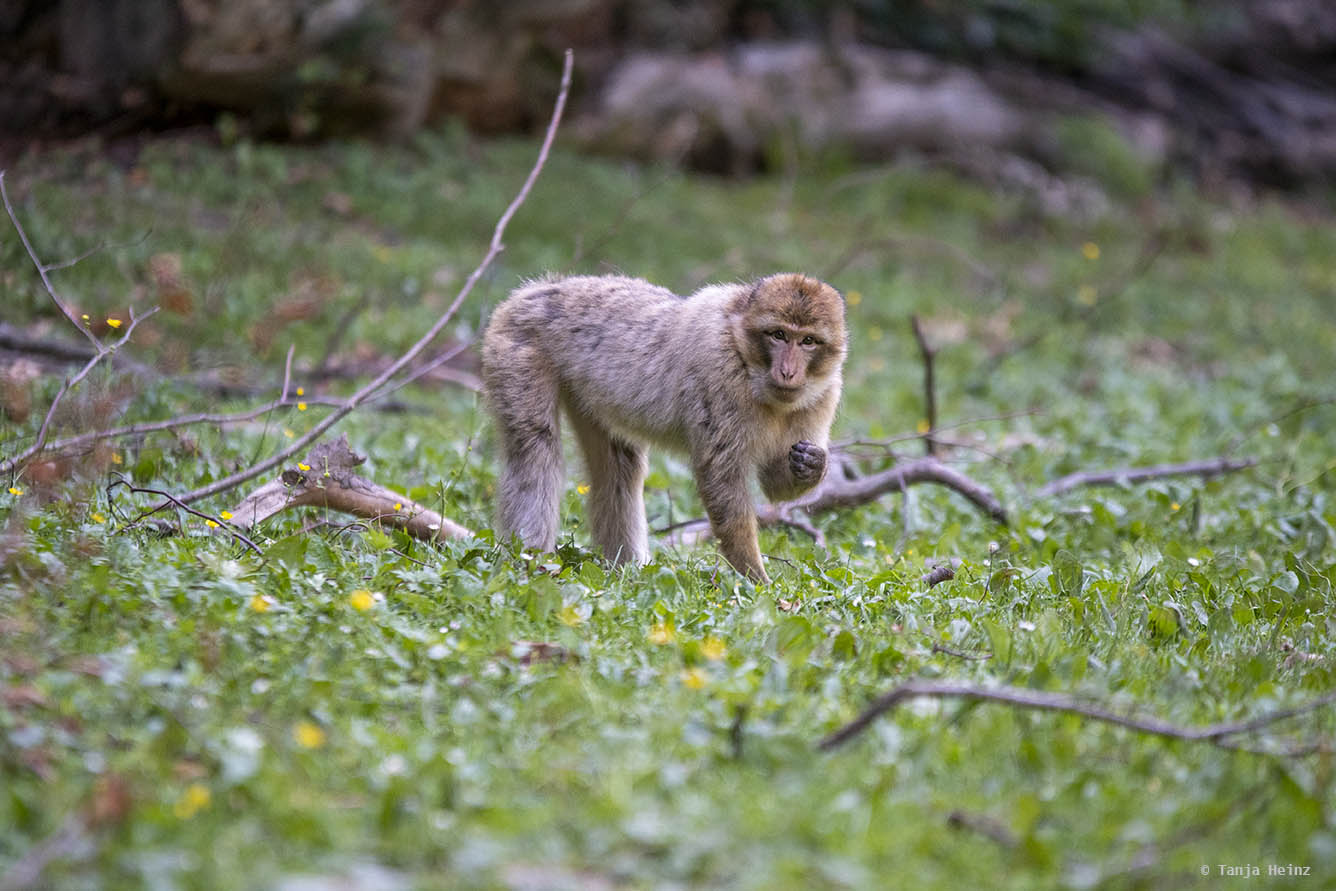
In their natural environment their diet might vary according to the season and the availability of food. The barbary macaque is omnivorous, and thus, very adaptable to seasonal fluctuations. Apparently, semi-free ranging barbary macaques have been observed to feed also on birds or small mammals. Therefore, barbary macaques might be flexible in terms of food when necessary which hopefully has positive consequences on their future survival on this planet.
Important: Please follow the rules of the Affenberg Salem. It is not allowed to touch the monkeys. And please keep a distance of more than 1 meter. It is allowed to give popcorn to the monkeys, but the popcorn is provided by the staff of the Affenberg Salem. Please do not feed the monkeys with other food items.
Nevertheless, the barbary macaque is an endangered species. Therefore, I will write more about the threats barbary macaques are exposed to in the next paragraph and which conservation efforts are applied including by the Affenberg Salem.
Conservation of the barbary macaque
On the Affenberg Salem I learned that habitat destruction and agriculture are the primary threats for barbary macaques. Deforestation and large cattle herds are two of the reasons why barbary macaques have to leave their natural habitat. As barbary macaques prefer cedar and oak forests their habitat becomes more and more fragmented as cedar and oak trees are used to make furniture and handicrafts.
Although barbary macaques can be found on the forest floor during the day, they sleep in trees, and thus, they need the forest.
On the Affenberg Salem I observed some barbary macaques in trees during the day.
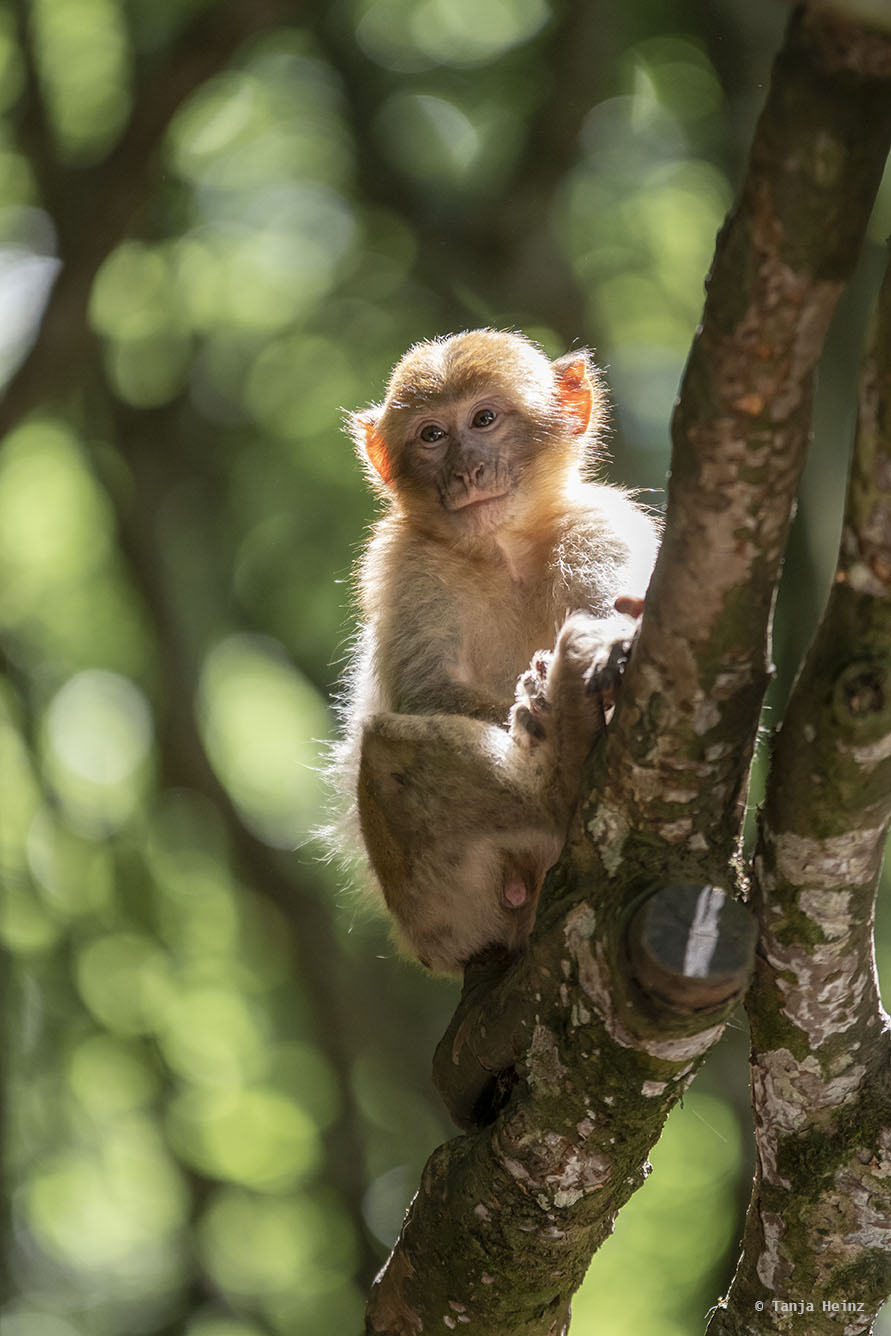
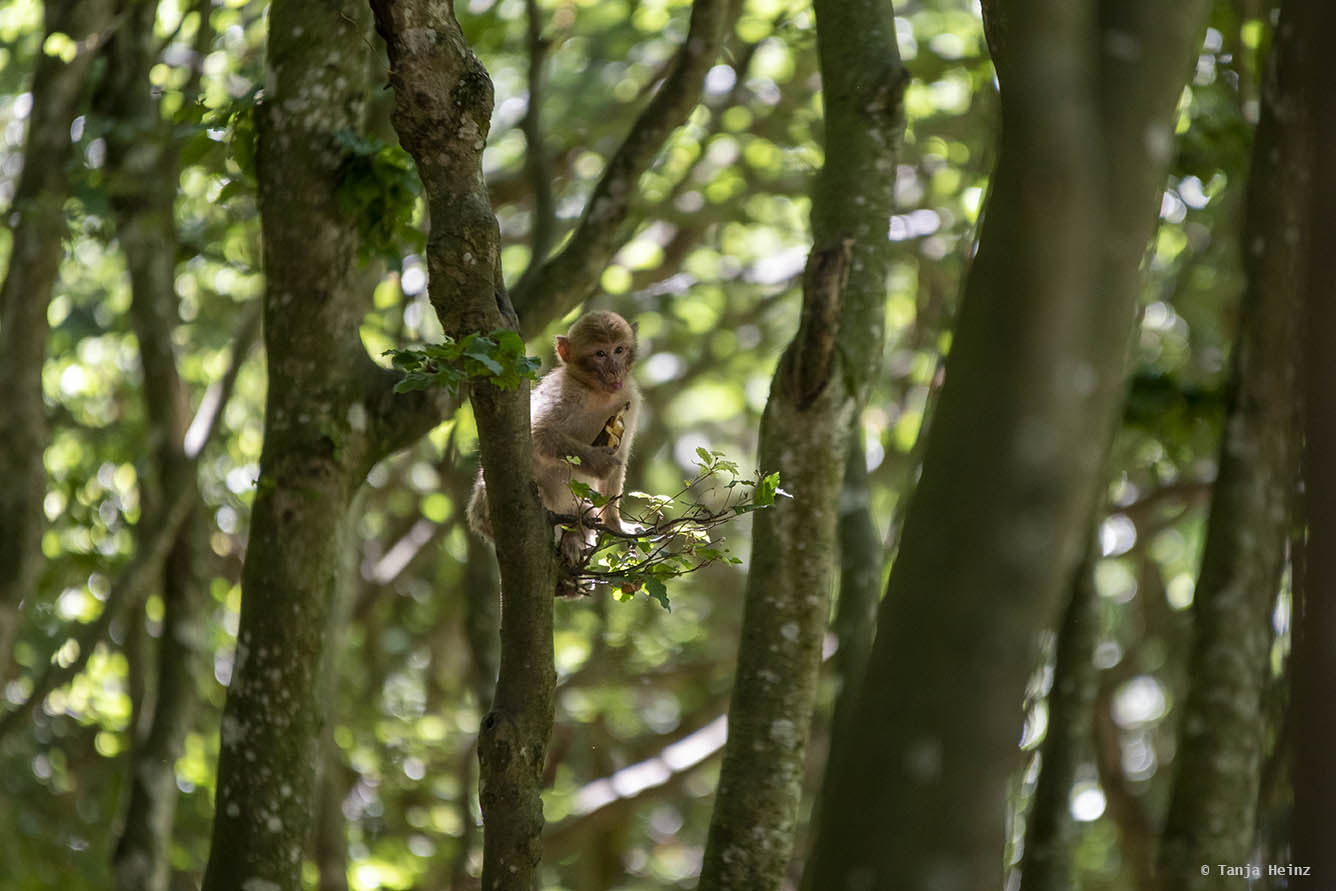
I think the destruction of our environment, and thus, the destruction of important habitat for wildlife, is taking place not only in the habitat of barbary macaques - that means in Algeria and Morocco. I just have to think of the golden lion tamarins or the southern muriquis and the Guiana dolphins in Brazil. And I’m concerned about this as human population is growing and growing.
Livestock overgrazing is another point that negatively affects barbary macaques. Goats and sheep remove forest undergrowth which prevents the regeneration of trees and shrubs. But not only less vegetation cover and a less diverse plant environment are problems. Also shepherd dogs might attack barbary macaques. Especially as these dogs protect the water for the livestock.
Did you know? According to estimations from the years 2006/2007 there are about between 6.000 to 10.000 barbary macaques left in the wild in Morocco and Algeria. In the past they also lived in Egypt, Libya and Tunisia where they are now considered as extinct.
One important thing I learned about the Affenberg Salem and why I like to visit places like this is the fact, that the park is involved in conservation efforts. That means, they implement reintroduction programs in order to increase the number of barbary macaques in the wild. For example, in 1980 and 1986 they could return about 600 barbary macaques to the wild again. As the barbary macaques can live on the Affenberg Salem almost like in their natural environment, the monkeys are capable of being reintroduced to the wild.
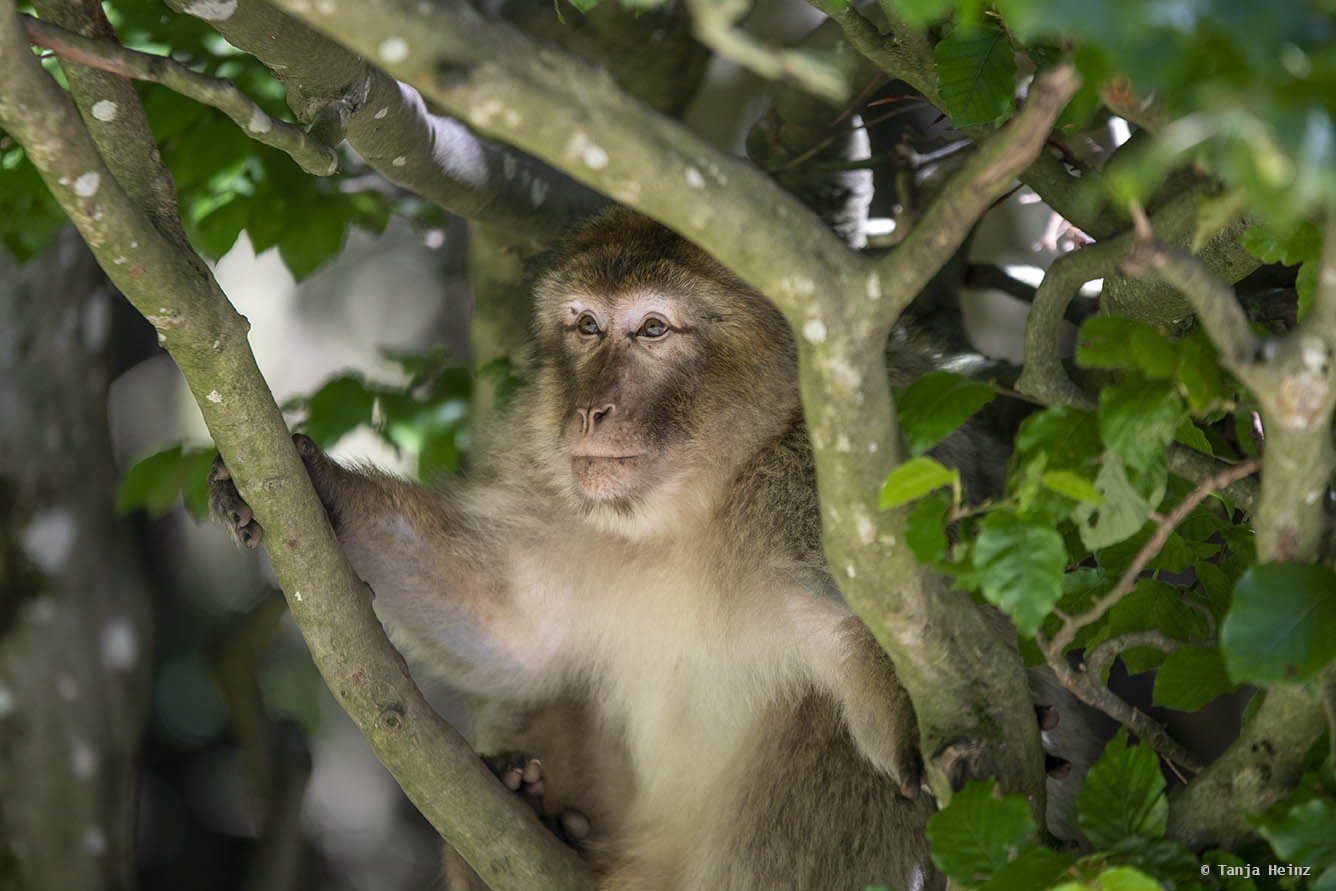
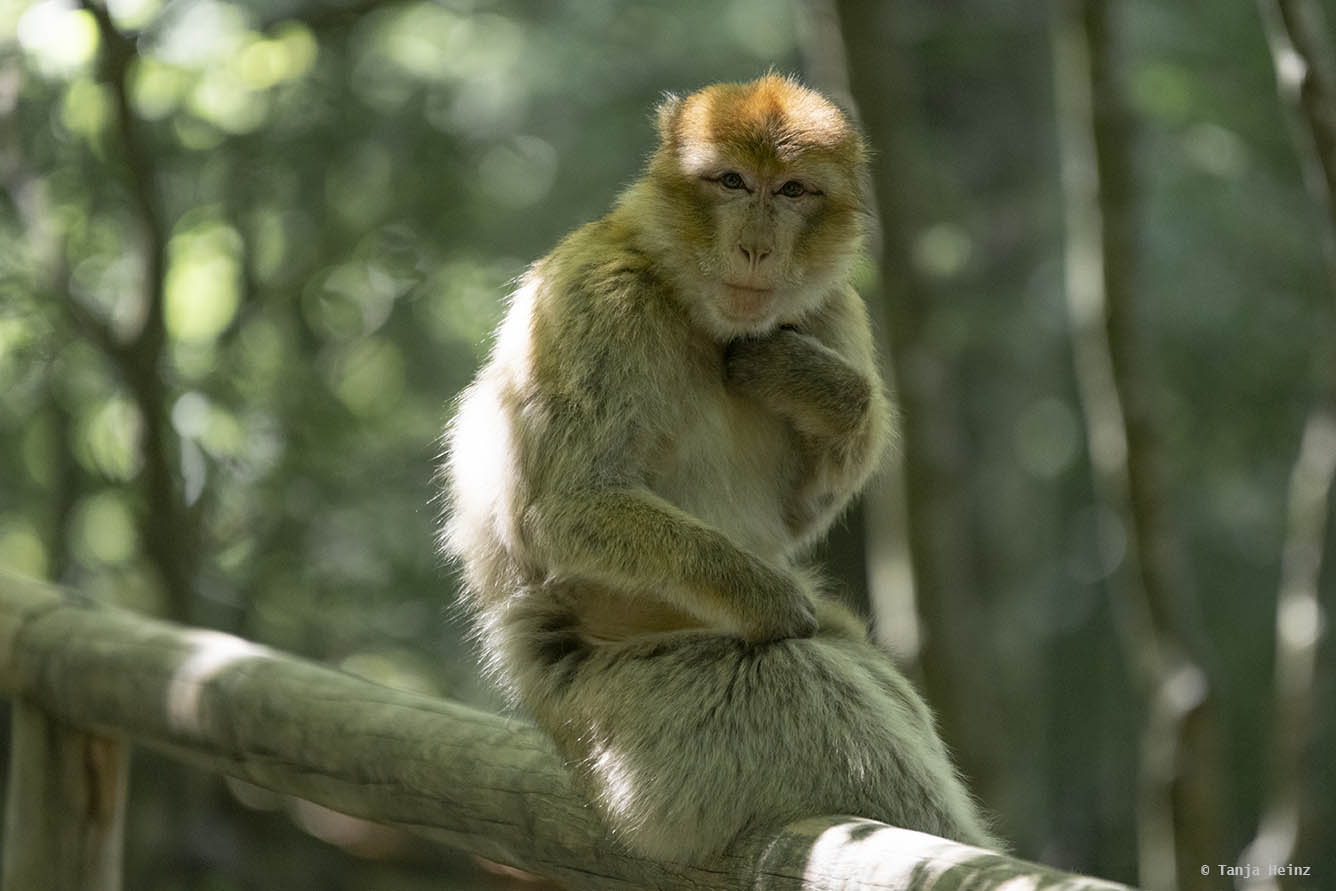
The Affenberg Salem works together with two other parks in France and England. All three parks together provide a safe home for about 10% monkeys of the worldwide barbary macaque population.
Interesting: Did you know that home ranges of barbary macaques can significantly vary? A home range might be as small as 400 square meters or as large as 8 square kilometers. The size of a home range depends to a great extent on the quality of a habitat. If food availability, water resources and sleeping sites are good, home ranges are smaller.
Illegal wildlife trade in infants is another threat barbary macaques are exposed to. Misled love for animals and ignorance might be one of the main reasons why a barbary macaque might end up as a pet. Baby barbary macaques usually look very cute for many people. But a baby barbary macaque which is taken from its group might suffer from the absence of its mother, family members and other playfellows. Often they become traumatized. Some barbary macaques might even end up in a circus, a TV show or in any other entertainment place.
On the Affenberg Salem they can live a life which is close to their life in Morocco and Algeria.
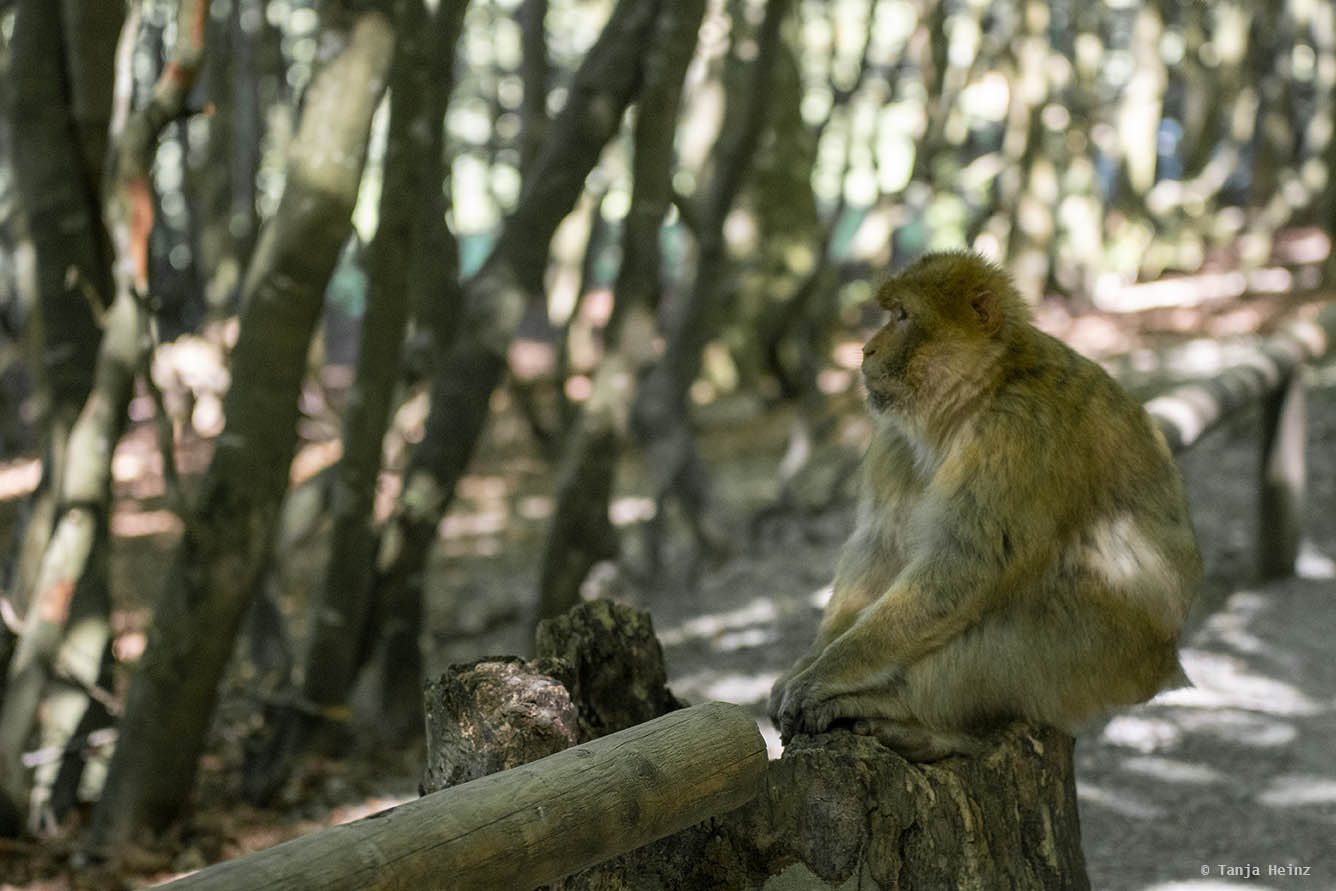
I think the Affenberg Salem is doing a great work making people aware of these issues. Barbary macaques are no pets! And places where animals are used just for the entertainment of people should not be visited!
Important: The Convention on International Trade in Endangered Species of Wild Fauna and Flora, also known as the Washington Convention (CITES), is a treaty signed by 183 countries (November 2019) to protect endangered animals and plants. That means, the trade of wild animals including the barbary macaques in Morocco and Algeria is not allowed, and thus, illegal.
One of the biggest challenge is probably the preservation of the natural habitat of the barbary macaque.
Maybe one other conservation effort could be the establishment of nature reserves?
Maybe it could promote a new source of income for the local community?
And maybe this could improve the conservation of the barbary macaque?
But important to mention here is also that tourism had already negatively affected wild populations of barbary macaques in the past. Especially when tourists start to feed the monkeys, barbary macaques approach roads and are being killed in road accidents. The risk of being poached also increases.
As much as I support a responsible way of an encounter with barbary macaques, we also need more education about how to approach animals - including barbary macaques - in the wild.
Practical information
How to get to the Affenberg Salem
Please check the blog entry about white storks on the Affenberg Salem for further information about how you can get to the park.
Resources and more information about the barbary macaque
The Amazing World of the barbary macaque by Wild Futures
"Berberaffe oder Magot (Macaca sylvanus)" on the Biologie Seite (only in German)
More about the barbary macaque on Wikipedia
Official website of the Affenberg Salem
"Gestural communication in macaques: usage and meaning of nonvocal signals" by Dario Maestripieri
Cindy in the news (only in German)
Have you already been on the Affenberg Salem? Did you like it? And what was the most interesting fact about barbary macaque monkeys for you? Let me know in the comments.
